This is a list of city and town halls in England. The list is sortable by building age and height, and provides a link to the listing description where relevant. Where the architect is not from the locality of the town hall, their hometown is included. The list, which was compiled using the list of 1,000 Largest Cities and Towns in the UK by Population, published by The Geographist, to ensure completeness, [1] includes over 800 surviving buildings. Notable examples of buildings which have not survived include the town halls of Kensington, Newcastle, Paddington and Sunderland. The oldest town hall, which was built as a chapel for pilgrims, is Dover Town Hall, thought to have been completed in around 1203, [2] while the oldest purpose-built town hall is Bury St Edmunds Guildhall, which dates back to around 1220. [3] The tallest town hall is Manchester Town Hall with a clock tower which rises to 280 feet (85 m). [4]
| Town or city | Building | Image | County | Built | Height | Notes |
|---|---|---|---|---|---|---|
| Abram | Abram Council Offices |  | Greater Manchester | 1903 | Architects: Heaton, Ralph and Heaton. | |
| Accrington | Accrington Town Hall |  | Lancashire | 1858 | Grade II* listed (1362011). Architects: James F. Green and T. Birtwhistle. | |
| Acton | Acton Town Hall | 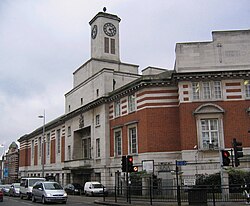 | Greater London | 1910 | Grade II listed (1390770). Architects: Raffles and Gridley. | |
| Addlestone | Runnymede Civic Centre |  | Surrey | 2008 | Architects: Feilden Clegg Bradley Studios. | |
| Adwick le Street | Adwick Town Hall |  | South Yorkshire | 1682 | ||
| Alcester | Alcester Town Hall |  | Warwickshire | 1641 | Grade I listed (1024606). Architect: Simon White. | |
| Aldeburgh | The Moot Hall |  | Suffolk | 1520 | Grade I listed (1269716). | |
| Aldershot | Aldershot Town Hall |  | Hampshire | 1904 | Grade II listed (1092638). Architect: Charles E. Hutchinson. | |
| Alnwick | Alnwick Town Hall |  | Northumberland | 1731 | Grade I listed (1157140). | |
| Alresford | Alresford Town Hall |  | Hampshire | 1866 | Grade II listed (1095198). Architect: William Hunt. | |
| Alston | Alston Town Hall |  | Cumbria | 1858 | Grade II listed (1106388). Architect: Alfred Burdakin Higham | |
| Alton | Alton Town Hall |  | Hampshire | 1813 | Grade II listed (1094175). | |
| Altrincham | Altrincham Town Hall |  | Greater Manchester | 1901 | Architect: Charles Albert Hindle. | |
| Altrincham | Old Town Hall, Altrincham |  | Greater Manchester | 1849 | Grade II listed (1067960). | |
| Amersham | Amersham Town Hall |  | Buckinghamshire | 1682 | Grade II* listed (1221420). | |
| Andover | Andover Guildhall |  | Hampshire | 1825 | Grade II* listed (1236337). | |
| Anerley | Anerley Town Hall |  | Greater London | 1879 | Architect: George Elkington. | |
| Appleby-in-Westmorland | The Moot Hall |  | Cumbria | 1596 | Grade II* listed (1145607). | |
| Arundel | Arundel Town Hall |  | West Sussex | 1838 | Grade II listed (1027921). Architect: Robert Abraham of London. | |
| Ashbourne | Ashbourne Town Hall |  | Derbyshire | 1861 | Grade II listed (1109530). Architect: Benjamin Wilson. | |
| Ashburton | Ashburton Town Hall |  | Devon | 1850 | Grade II listed (1201012). Architect: Alfred Norman. | |
| Ashby-de-la-Zouch | Ashby-de-la-Zouch Town Hall |  | Leicestershire | 1857 | Grade II listed (1073608). Architect: Henry Isaac Stevens of Derby. | |
| Ashington | Ashington Town Hall |  | Northumberland | 1913 | ||
| Ashton-under-Lyne, Tameside | Ashton Town Hall |  | Greater Manchester | 1840 | Grade II listed (1067995). Architects: William Young of Glasgow and Charles Lee of London. | |
| Atherton | Atherton Town Hall |  | Greater Manchester | 1900 | Architect: James Caldwell Prestwich. | |
| Axbridge | Axbridge Town Hall |  | Somerset | 1830 | Grade II listed (1344886). | |
| Axminster | Axminster Guildhall |  | Devon | 1931 | ||
| Aylesbury | Aylesbury Town Hall |  | Buckinghamshire | 1865 | Grade II* listed (1117935). Architect: David Brandon. | |
| Aylsham | Aylsham Town Hall |  | Norfolk | 1857 | Grade II listed (1306405). | |
| Bacup | Bacup Town Hall |  | Lancashire | 1808 | Grade II listed (1163375). | |
| Bakewell | Bakewell Town Hall |  | Derbyshire | 1890 | Architect: George E. Statham. | |
| Bakewell | Old Town Hall, Bakewell |  | Derbyshire | 1602 | Grade II listed (1246178). | |
| Baldock | Baldock Town Hall |  | Hertfordshire | 1897 | Locally listed. | |
| Bampton | Bampton Town Hall |  | Oxfordshire | 1838 | Grade II listed (1198742). Architect: George Wilkinson. | |
| Banbury | Banbury Town Hall |  | Oxfordshire | 1854 | Grade II listed (1369525). Architect: Edward George Bruton. | |
| Barking | Barking Town Hall |  | Greater London | 1958 | Architect: Herbert Jackson and Reginald Edmonds. | |
| Barking | Old Town Hall, Barking |  | Greater London | 1893 | Grade II listed (1359304). Architect: Charles James Dawson. | |
| Barnsley | Barnsley Town Hall | 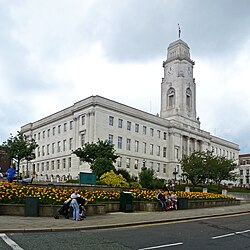 | South Yorkshire | 1933 | 44 metres (144 ft) | Grade II listed (1067995). Architects: Briggs and Thornely of Liverpool. |
| Barnstaple | Barnstaple Guildhall |  | Devon | 1828 | Grade II* listed (1385188). Architect: Thomas Lee. | |
| Barrow-in-Furness | Barrow-in-Furness Town Hall |  | Cumbria | 1887 | 50 metres (164 ft) | Grade II* listed (1197859). Architect: William Henry Lynn of Belfast. |
| Basingstoke | Basingstoke Town Hall |  | Hampshire | 1835 | Grade II listed (1230876). Architect: Lewis Wyatt. | |
| Bath | The Guildhall |  | Somerset | 1778 | Grade I listed (1396021). Architect: Thomas Baldwin. | |
| Batley | Batley Town Hall |  | West Yorkshire | 1854 | Grade II listed (1300324). | |
| Battersea | Battersea Town Hall |  | Greater London | 1893 | Grade II* listed (1184293). Now used for Battersea Arts Centre. Architect: Edward William Mountford. | |
| Bawtry | Old Town Hall, Bawtry |  | South Yorkshire | 1890 | ||
| Beaconsfield | Beaconsfield Town Hall | Buckinghamshire | 1936 | Architects: Burgess, Holden & Watson together with John Crosby. | ||
| Beccles | Beccles Town Hall |  | Suffolk | 1726 | Grade II listed (1205749). | |
| Bedford | Old Town Hall, Bedford |  | Bedfordshire | 1550 | Grade II listed (1114520). Architect: Isaac Clayson. | |
| Bedminster | Bedminster Town Hall |  | Bristol | 1891 | ||
| Beeston | Beeston Town Hall |  | Nottinghamshire | 1938 | Architects: Evans, Clark and Woollatt. | |
| Bellingham | Bellingham Town Hall |  | Northumberland | 1862 | Grade II listed (1153580). | |
| Bentham | Bentham Town Hall |  | North Yorkshire | 1877 | ||
| Berkeley | Berkeley Town Hall |  | Gloucestershire | 1824 | Grade II listed (1222026). | |
| Berkhamsted | Berkhamsted Civic Centre |  | Hertfordshire | 1938 | Architect: John Hadfield. | |
| Berkhamsted | Berkhamsted Town Hall |  | Hertfordshire | 1859 | Grade II listed (1078138). Architect: Edward Buckton Lamb of London. | |
| Bermondsey | Bermondsey Town Hall |  | Greater London | 1930 | Grade II listed (1385930). Architect: Henry Tansley. | |
| Berwick-upon-Tweed | Berwick Town Hall |  | Northumberland | 1760 | 46 metres (151 ft) | Grade I listed (1290051). Architect: Samuel and John Worrell. |
| Bethnal Green | Bethnal Green Town Hall | 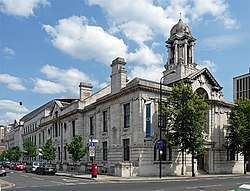 | Greater London | 1910 | Grade II listed (1065243). Architects: Percy Robinson and William Alban Jones. | |
| Beverley | Beverley Guildhall |  | East Riding of Yorkshire | 1320 | Grade I listed (1083960) | |
| Bewdley | Bewdley Guildhall |  | Worcestershire | 1808 | Grade II* listed (1100788). Architect: John Simpson of Shrewsbury. | |
| Bexhill-on-Sea | Bexhill Town Hall |  | East Sussex | 1895 | Grade II listed (1483735). Architect: Henry Ward. | |
| Bexleyheath | Bexley Civic Offices |  | Greater London | 1989 | Architect (for the conversion to Civic Offices): Bennetts Associates. | |
| Biddulph | Biddulph Town Hall |  | Staffordshire | 1965 | ||
| Bideford | Bideford Town Hall |  | Devon | 1851 | Grade II listed (1200934). Architects: Richard Davie Gould and Alfred Dunn. | |
| Biggleswade | Old Town Hall, Biggleswade |  | Bedfordshire | 1844 | Grade II listed (1321421). Architect: James Tacy Wing. | |
| Billericay | Old Town Hall, Billericay |  | Essex | 1830 | ||
| Bilston | Bilston Town Hall |  | West Midlands | 1873 | Grade II listed (1201834). Architect: Bidlake and Lovatt. | |
| Bingley | Bingley Town Hall |  | West Yorkshire | 1770 | Grade II listed (1314271). | |
| Birkenhead, Wirral | Birkenhead Town Hall |  | Merseyside | 1887 | 61 metres (200 ft) | Grade II* listed (1201582). Architect: Christopher Ellison. |
| Birmingham | Council House |  | West Midlands | 1879 | 29 metres (95 ft) | Grade II* listed (1210333). Architect: Yeoville Thomason. |
| Birmingham | Birmingham Town Hall |  | West Midlands | 1834 | Grade I listed (1343161). Used as a concert hall. Architects: Joseph Hansom & Edward Welch. | |
| Bishop Auckland | Bishop Auckland Town Hall |  | County Durham | 1862 | Grade II* listed (1297550). Now houses public library, theatre, art gallery, tourist information centre and café-bar. Architect: John Philpott Jones. | |
| Bishop's Castle | Bishop's Castle Town Hall |  | Shropshire | 1750 | Grade II* listed (1054552). Architect: William Baker. | |
| Blackburn | Blackburn Town Hall |  | Lancashire | 1856 | 60 metres (197 ft) (annexe) | Grade II listed (1239734). Architect: James Patterson. |
| Blackpool | Blackpool Town Hall |  | Lancashire | 1900 | Grade II listed (1205893). Architects: Potts, Son and Hennings of Oldham. | |
| Blandford Forum | Blandford Forum Town Hall |  | Dorset | 1734 | Grade I listed (1324806). Architects: John and William Bastard. | |
| Bodmin | Bodmin Guildhall |  | Cornwall | 1536 | Grade II listed (1206466). | |
| Bognor Regis | Bognor Regis Town Hall |  | West Sussex | 1930 | Grade II listed (1350337). Architects: Charles Cowles-Voysey. | |
| Bolton | Bolton Town Hall |  | Greater Manchester | 1866–1873 | 61 metres (200 ft) | Grade II* listed (1388295). Architect: William Hill of Leeds. Extended in the 1930s to the designs of Bradshaw, Gass and Hope. |
| Bootle | Bootle Town Hall |  | Merseyside | 1882 | Grade II listed (1075891). Architect: John Johnson of London. | |
| Bosham | Old Town Hall, Bosham |  | West Sussex | 1694 | Grade II listed (1229816). | |
| Boston | Municipal Buildings |  | Lincolnshire | 1904 | Architect: James Rowell. | |
| Bourne | Bourne Town Hall |  | Lincolnshire | 1821 | Grade II listed (1242224). Architect: Bryan Browning. | |
| Bournemouth | Bournemouth Town Hall |  | Dorset | 1885 | Grade II listed (1389612). Architect: Alfred Bedborough. | |
| Bovey Tracey | Bovey Tracey Town Hall |  | Devon | 1866 | Grade II listed (1165878). | |
| Brackley | Brackley Town Hall |  | Northamptonshire | 1706 | Grade II* listed (1190100). | |
| Bradford | Bradford City Hall |  | West Yorkshire | 1873 | 67 metres (220 ft) | Grade I listed (1388295). Architects: Lockwood and Mawson. |
| Bradford-on-Avon | Bradford-on-Avon Town Hall |  | Wiltshire | 1854 | Grade II listed (1364518). Architect: Thomas Fuller of Bath. | |
| Brading | New Town Hall, Brading |  | Isle of Wight | 1903 | Architect: James Newman. | |
| Brading | Old Town Hall, Brading |  | Isle of Wight | 1730 | Grade II listed (1219522). | |
| Bradninch | Bradninch Guildhall |  | Devon | 1835 | Grade II listed (1326117). | |
| Braintree | Braintree Town Hall |  | Essex | 1928 | Grade II* listed (1235026). Architect: E. Vincent Harris. | |
| Brampton | The Moot Hall |  | Cumbria | 1817 | Grade II* listed (1137330). | |
| Brent | Brent Civic Centre | 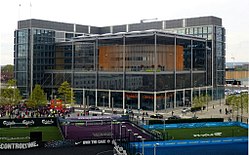 | Greater London | 2013 | 46 metres (151 ft) | Architect: Hopkins. |
| Brent | Brent Town Hall |  | Greater London | 1940 | Grade II listed (1262141). Now Lycée International de Londres Winston Churchill. Architect: Clifford Strange. | |
| Brentwood | Brentwood Town Hall |  | Essex | 1957 | Architects: John Brandon-Jones, Ashton & Broadbent. | |
| Bridgnorth | Bridgnorth Town Hall |  | Shropshire | 1652 | Grade II* listed (1053998). | |
| Bridgwater | Bridgwater Town Hall |  | Somerset | 1823 | Grade II* listed (1280140). Architects: Richard Carver and Charles Knowles. | |
| Bridlington | Bridlington Town Hall |  | East Riding of Yorkshire | 1932 | Grade II listed (1334329). Architect: Percy Maurice Newton. | |
| Bridport | Bridport Town Hall |  | Dorset | 1786 | Grade I listed (1227851). Architect: William Tyler RA of London. | |
| Brierfield | Brierfield Town Hall |  | Lancashire | 1833 | Grade II listed (1361692). | |
| Brigg | Brigg Town Hall |  | Lincolnshire | 1819 | Grade II listed (1083130). | |
| Brighouse | Brighouse Town Hall |  | West Yorkshire | 1887 | Grade II listed (1133856). Architect: John Lord. | |
| Brighton | Brighton Town Hall |  | East Sussex | 1832 | Grade II listed (1379974). Architect: Thomas Cooper. | |
| Bristol | Bristol City Hall |  | Bristol | 1952 | Grade II* listed (1282341). Known as the Council House until 2012. Architect: Vincent Harris. | |
| Bristol | Old Council House |  | Bristol | 1827 | Grade II* listed (1207433). Architect: Sir Robert Smirke of London. | |
| Brixham | Brixham Town Hall |  | Devon | 1886 | Grade II listed (1298263). Architect: George Bridgman. | |
| Bromley | Bromley Civic Centre |  | Greater London | 1988 | ||
| Bromley | Bromley Palace |  | Greater London | 1776 | Grade II listed (1281268). | |
| Bromley | Bromley Town Hall |  | Greater London | 1906 | Grade II listed (1299012). Architect: R. Frank Atkinson. | |
| Broughton-in-Furness | Old Town Hall, Broughton-in-Furness |  | Cumbria | 1766 | Grade II listed.(1138235). | |
| Brownhills | Council House, Brownhills |  | West Midlands | 1882 | Locally listed. Architect: John Siddalls. | |
| Buckfastleigh | Buckfastleigh Town Hall |  | Devon | 1887 | Architect: James Hine of Hine & Odgers in Plymouth. | |
| Buckingham | Buckingham Town Hall |  | Buckinghamshire | 1783 | Grade II* listed (1282685). | |
| Bulwell | Old Town Hall, Bulwell |  | Nottinghamshire | 1894 | ||
| Burford | The Tolsey |  | Oxfordshire | 1520 | Grade II* listed (1224632). | |
| Burnley | Burnley Town Hall |  | Lancashire | 1888 | 27 metres (89 ft) | Grade II listed (1244910). Architects: Henry Holtom and George Arthur Fox. |
| Burslem, Stoke-on-Trent | Old Town Hall, Burslem |  | Staffordshire | 1857 | Grade II* listed (1195811). Architect: GT Robinson of Leamington. | |
| Burton upon Trent | Burton upon Trent Town Hall | 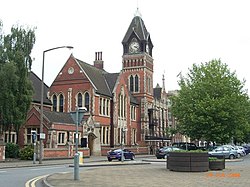 | Staffordshire | 1878 | Grade II listed (1038703). Architect: Reginald Churchill. | |
| Bury | Bury Town Hall | 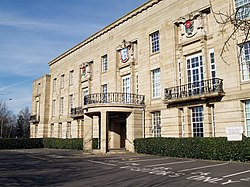 | Greater Manchester | 1954 | Locally listed. Architect: Reginald Edmonds. | |
| Bury St Edmunds | Bury St Edmunds Guildhall |  | Suffolk | 1220 | Grade I listed (1363726). Used as event and exhibition space. | |
| Bury St Edmunds | Bury St Edmunds Town Hall |  | Suffolk | 1780 | Grade I listed (1076930). Architect: Robert Adam of London. | |
| Buxton | Buxton Town Hall |  | Derbyshire | 1889 | Grade II listed (1259171). Architect: William Pollard of Manchester. | |
| Calne | Calne Town Hall |  | Wiltshire | 1886 | Grade II listed (1270827). Architect: Bryan Oliver. | |
| Camberwell | Camberwell Town Hall | 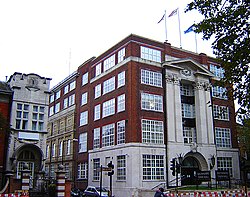 | Greater London | 1934 | Architects: Culpin and Bowers. | |
| Camborne | Camborne Council Offices |  | Cornwall | 1903 | Grade II listed (1142644). | |
| Camborne | Camborne Town Hall |  | Cornwall | 1867 | Grade II listed (1311028). | |
| Cambridge | Cambridge Guildhall |  | Cambridgeshire | 1939 | Grade II listed (1268372). Architect: Charles Cowles-Voysey. | |
| Camden | Camden Town Hall |  | Greater London | 1937 | Grade II listed (1379162). Known as St Pancras Town Hall until 1965. Architect: Albert Thomas. | |
| Camelford | Camelford Town Hall |  | Cornwall | 1806 | Grade II listed (1138348). | |
| Canterbury | Canterbury Guildhall |  | Kent | 1381 | Grade II* listed (1241661). | |
| Carlisle | Old Town Hall, Carlisle | 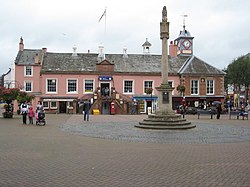 | Cumbria | 1669 | Grade I listed (1218104). | |
| Carlisle | Carlisle Civic Centre |  | Cumbria | 1964 | 44 metres (144 ft) | Architects: Charles B. Pearson and Partners. |
| Carshalton | Carshalton Council Offices | 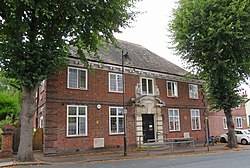 | Greater London | 1908 | Grade II listed (1300429). Architects: R. Frank Atkinson and W. Willis Gale. | |
| Carterton | Carterton Town Hall |  | Oxfordshire | 1983 | ||
| Castle Cary | Castle Cary Town Hall |  | Somerset | 1855 | Grade II* listed (1056254). Architect: Francis Penrose. | |
| Castleford | Castleford Civic Centre |  | West Yorkshire | 1970 | Architects: Griffiths Lewis Goad Partnership. | |
| Chadderton | Chadderton Town Hall |  | Greater Manchester | 1913 | Grade II listed (1404904). Architects: Taylor & Simister. | |
| Chapel-en-le-Frith | Chapel-en-le-Frith Town Hall |  | Derbyshire | 1851 | ||
| Chard | Chard Guildhall |  | Somerset | 1835 | Grade II* listed (1197456). Architect: Richard Carver. | |
| Chatham | Chatham Town Hall |  | Kent | 1900 | Grade II listed (1268228). Architect: George Edward Bond. | |
| Cheetham | Cheetham Town Hall |  | Greater Manchester | 1855 | Grade II listed (1208440). Architect: Thomas Bird. | |
| Chelmsford | Chelmsford Civic Centre |  | Essex | 1935 | Locally listed. Architects: Cordingley & McIntyre. | |
| Chelsea | Chelsea Town Hall |  | Greater London | 1887 | Part Grade II* listed (1294164), part Grade II listed (1224630). Architect: John McKean Brydon (older part) and Leonard Stokes (newer part). | |
| Cheltenham | Cheltenham Town Hall |  | Gloucestershire | 1903 | Grade II listed (1104376). Architect: Frederick William Waller. | |
| Cheltenham | Cheltenham Municipal Offices |  | Gloucestershire | 1840 | Grade II* listed (1387631). Architect: George Allen Underwood. | |
| Chertsey | Old Town Hall, Chertsey |  | Surrey | 1851 | Grade II listed (1295138). Architect: George Briand. | |
| Chester | Chester Town Hall |  | Cheshire | 1869 | 49 metres (161 ft) | Grade II* listed (1376371). Architect: William Henry Lynn of Belfast. |
| Chesterfield | Chesterfield Town Hall |  | Derbyshire | 1938 | Grade II listed (1113305). Architect: Bradshaw Gass & Hope of Bolton. | |
| Chichester | The Council House |  | West Sussex | 1731 | Grade II* listed (1354331). Architects: Roger Morris and James Wyatt. | |
| Chingford | Chingford Town Hall |  | Greater London | 1929 | Locally listed. Architects: Frank Nash and H.T. Bonner. | |
| Chippenham | Yelde Hall |  | Wiltshire | 1450 | Grade I listed (1267996). | |
| Chippenham | Chippenham Town Hall |  | Wiltshire | 1834 | Grade II listed (1268113). Architect: James Thomson. | |
| Chipping Campden | Chipping Campden Town Hall |  | Gloucestershire | 1897 | Grade II* listed (1078401). | |
| Chipping Norton | Chipping Norton Town Hall |  | Oxfordshire | 1842 | Grade II listed (1183188). Architect: George Stanley Repton. | |
| Chipping Sodbury | Chipping Sodbury Town Hall |  | Gloucestershire | 1858 | Grade II listed (1129244). | |
| Chiswick | Chiswick Town Hall |  | Greater London | 1876 | Grade II listed (1260615). Architect: W. J. Trehearne. | |
| Chorley | Chorley Town Hall | 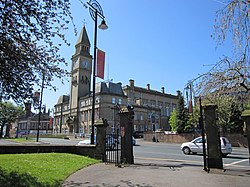 | Lancashire | 1879 | Architects: John Ladds and William Henry Powell. | |
| Chorlton-on-Medlock | Chorlton-on-Medlock Town Hall | 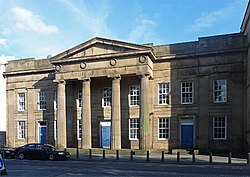 | Greater Manchester | 1831 | Grade II listed (1283062). Architect: Richard Lane. | |
| Christchurch | Christchurch Town Hall | 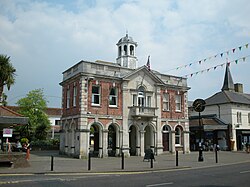 | Dorset | 1746 | Grade II listed (1324677). | |
| Chudleigh | Chudleigh Town Hall |  | Devon | 1865 | Grade II listed (1334259). | |
| City of London | The Guildhall |  | Greater London | 1440 | Grade I listed (1064675). | |
| Clacton-on-Sea | Clacton Town Hall |  | Essex | 1931 | Grade II listed (1267903). Architect: Sir Alfred Brumwell Thomas of London. | |
| Clare | Clare Town Hall |  | Suffolk | 1913 | Architect: Percy Monroe Beaumont. | |
| Cleckheaton | Cleckheaton Town Hall |  | West Yorkshire | 1892 | Grade II listed (1313688). Architects: Mawson & Hudson. | |
| Cleethorpes | Cleethorpes Town Hall |  | Lincolnshire | 1905 | Grade II listed (1103474). Architect: Herbert Scaping. | |
| Clevedon | Clevedon Town Hall |  | Somerset | 1860 | Grade II listed (1113001). | |
| Clitheroe | Old Town Hall, Clitheroe |  | Lancashire | 1820 | 19 metres (62 ft) | Grade II listed (1072374). Architect: Thomas Rickman. |
| Clun | Clun Town Hall |  | Shropshire | 1780 | Grade II* listed (1054426). | |
| Cockermouth | Cockermouth Town Hall |  | Cumbria | 1841 | Grade II listed (1055821). | |
| Colchester | Colchester Town Hall |  | Essex | 1902 | 59 metres (194 ft) | Grade II listed (1337736). Architect: John Belcher of London. |
| Colne | Colne Town Hall |  | Lancashire | 1894 | Grade II listed (1073412). Architect: Alfred Waterhouse. | |
| Colyton | Colyton Town Hall |  | Devon | 1927 | Architect: J. Archibald Lucas. | |
| Congleton | Congleton Town Hall |  | Cheshire | 1866 | 34 metres (112 ft) | Grade II* listed (1086996). Architect: Edward William Godwin of London. |
| Corbridge | Corbridge Town Hall |  | Northumberland | 1887 | Grade II listed (1044757). Architect: Frank Emley. | |
| Corby | Corby Cube |  | Northamptonshire | 2010 | Architect: Hawkins\Brown | |
| Corfe Castle | Corfe Castle Town Hall |  | Dorset | 1774 | Grade II* listed (1121006). | |
| Corsham | Corsham Town Hall |  | Wiltshire | 1882 | Grade II listed (1284062). Architect: William Harris Bromley. | |
| Cottingley | Cottingley Town Hall |  | West Yorkshire | 1865 | Grade II listed (1314305). Architect: Samuel Jackson. | |
| Coventry | Council House |  | West Midlands | 1917 | Grade II listed (1342927). Architect: Edward Garret and H W Simister of Birmingham. | |
| Crawley | Crawley Town Hall |  | West Sussex | 2022 | Architects: Cartwright Pickard. | |
| Crayford | Crayford Town Hall |  | Greater London | 1915 | Locally listed. | |
| Crediton | Old Town Hall, Crediton |  | Devon | 1852 | Grade II listed (1208961). Architect: Richard Davie Gould of Barnstaple. | |
| Crewe | Crewe Municipal Buildings |  | Cheshire | 1905 | Grade II listed (1136190). Architect: Henry Hare of London. | |
| Crewkerne | Crewkerne Town Hall |  | Somerset | 1742 | Grade II listed (1281919). | |
| Cricklade | Old Town Hall, Cricklade |  | Wiltshire | 1861 | Grade II listed (1023124). Architect: James Lansdown. | |
| Cromer | Old Town Hall, Cromer |  | Norfolk | 1890 | Grade II listed (1171785). Architect: George Skipper of Norwich. | |
| Croydon | Croydon Town Hall |  | Greater London | 1896 | 49 metres (161 ft) | Grade II listed (1188798). Architect: Charles Henman. |
| Cullompton | Cullompton Town Hall |  | Devon | 1903 | ||
| Dagenham | Dagenham Civic Centre |  | Greater London | 1937 | Grade II listed (1064422). Architect: Ernest Berry Webber. | |
| Dalton-in-Furness | Dalton Town Hall |  | Cumbria | 1884 | Grade II listed (1218867). Architect: John Young McIntosh. | |
| Darlington | Darlington Town Hall |  | County Durham | 1970 | Architect: Williamson, Faulkner Brown and Partners. | |
| Darlington | Old Town Hall and Market Hall | 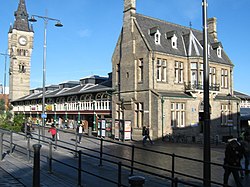 | County Durham | 1864 | Grade II listed (1121276). Architect: Alfred Waterhouse. | |
| Dartford | Dartford Civic Centre |  | Kent | 1975 | ||
| Darwen | Darwen Town Hall | 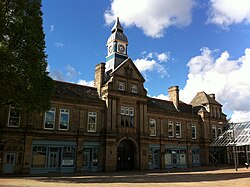 | Lancashire | 1882 | Architect: Charles Bell of Bourne. | |
| Daventry | The Moot Hall |  | Northamptonshire | 1769 | Grade II* listed (1067667). | |
| Dawley | Dawley Town Hall |  | Shropshire | 1873 | Architect: Mr Patterson. | |
| Deal | Deal Town Hall |  | Kent | 1803 | Grade II listed (1363477). Architect: John Mathews. | |
| Deddington | Deddington Town Hall |  | Oxfordshire | 1611 | Grade II* listed (1300780). | |
| Denton | Denton Town Hall |  | Greater Manchester | 1889 | Architects: T. D. and J. Lindley. | |
| Deptford | Deptford Town Hall |  | Greater London | 1905 | Grade II listed (1193691). Architects: Henry Vaughan Lanchester, James Stewart and Edwin Alfred Rickards. | |
| Derby | Council House | 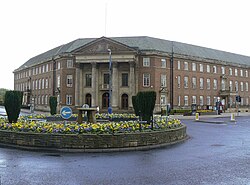 | Derbyshire | 1949 | Architect: Charles Aslin. | |
| Derby | Derby Guildhall |  | Derbyshire | 1828 | Grade II listed (1228604). Architects: Matthew Habershon and Henry Duesbury. | |
| Devizes | Devizes Town Hall |  | Wiltshire | 1808 | Grade II* listed (1262331). Architect: Thomas Baldwin of Bath. | |
| Devizes | Old Town Hall |  | Wiltshire | 1752 | Grade II* listed (1252446). Architect: Lawrence. | |
| Devonport | Devonport Guildhall |  | Devon | 1824 | Grade I listed (1322009). Architect: John Foulston. | |
| Dewsbury | Dewsbury Town Hall |  | West Yorkshire | 1889 | Grade II listed (1134707). Architects: Henry Holtom and George Arthur Fox. | |
| Diss | Diss Town Hall |  | Norfolk | 1830 | Grade II listed (1170035). | |
| Doncaster | Doncaster Civic Office | 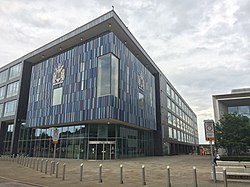 | South Yorkshire | 2012 | Architects: Cartwright Pickard. | |
| Dorchester | Municipal Buildings |  | Dorset | 1848 | Grade II* listed (1110585). Architects: Benjamin Ferrey of London. | |
| Dover | Dover Town Hall | 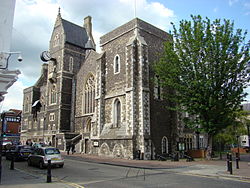 | Kent | 1203 | Grade I listed (1069499). | |
| Downham Market | Downham Market Town Hall |  | Norfolk | 1887 | Grade II listed (1342634). Architect: John Johnson. | |
| Driffield | Driffield Town Hall |  | East Riding of Yorkshire | 1841 | Architect: Henry Francis Lockwood of Hull. | |
| Droitwich Spa | Old Town Hall, Droitwich Spa |  | Worcestershire | 1826 | Grade II listed (1095978). | |
| Dronfield | Dronfield Civic Hall |  | Derbyshire | 1999 | ||
| Dudley | Dudley Council House |  | West Midlands | 1935 | Grade II listed (1393758). Architects: Harvey and Wicks. | |
| Dukinfield | Dukinfield Town Hall |  | Greater Manchester | 1901 | Grade II listed (1403441). Architect: John Eaton, Sons and Cantrell. | |
| Dulverton | Dulverton Town Hall |  | Somerset | 1866 | Grade II listed (1247925). | |
| Dunstable | Dunstable Municipal Offices |  | Bedfordshire | 1747 | Grade II listed (1138223). | |
| Dunwich | Old Town Hall, Dunwich |  | Suffolk | 1705 | Grade II listed (1198313). | |
| Durham | Durham Town Hall |  | County Durham | 1665 | Grade II* listed (1160184). Architect: Philip Charles Hardwick of London. | |
| Dursley | Dursley Town Hall |  | Gloucestershire | 1738 | Grade II* listed (1220689). | |
| Ealing | Ealing Town Hall |  | Greater London | 1888 | Grade II listed (1358791). Architect: Charles Jones. | |
| Ealing | Old Town Hall, Ealing |  | Greater London | 1874 | Grade II listed (1189300). Architect: Charles Jones. | |
| Earlestown | Earlestown Town Hall |  | Merseyside | 1893 | Grade II listed (1392639). Architect: Thomas Beesley. | |
| Easingwold | Easingwold Town Hall |  | North Yorkshire | 1864 | Architect: Edward Taylor. | |
| East Barnet | East Barnet Town Hall |  | Greater London | 1892 | Locally listed. Architect: Frederick William Shenton. | |
| Eastbourne | Eastbourne Town Hall | 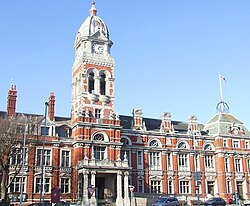 | East Sussex | 1886 | 40 metres (131 ft) | Grade II listed (1043621). Architect: William Tadman-Faulkes. |
| East Cowes | East Cowes Town Hall |  | Isle of Wight | 1897 | Locally listed. Architect: James Newman. | |
| Eastleigh | Eastleigh Town Hall |  | Hampshire | 1899 | Architects: Mitchell, Son and Gutteridge. | |
| Eccles | Eccles Town Hall | 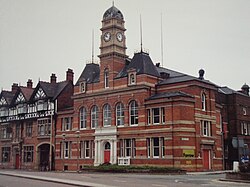 | Greater Manchester | 1881 | Architect: John Lowe. | |
| Egremont | Egremont Town Hall |  | Cumbria | 1890 | Grade II listed (1086707). | |
| Elland | Elland Town Hall |  | West Yorkshire | 1888 | Grade II listed (1248018). Architect: Charles Frederick Luke Horsfall. | |
| Ellesmere | Old Town Hall, Ellesmere |  | Shropshire | 1833 | Grade II listed (1055513). Architect: Edward Haycock of Shrewsbury. | |
| Ellesmere Port | Ellesmere Port Council Offices |  | Cheshire | 1969 | ||
| Emsworth | Emsworth Town Hall |  | Hampshire | 1790 | Architects: John Painter and John Sueter. | |
| Enfield | Enfield Civic Centre |  | Greater London | 1961 | 49 metres (161 ft) | Architects: Eric G Broughton & Associates. |
| Epping | Epping Civic Offices | 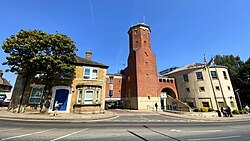 | Essex | 1992 | Grade II listed (1451630). Architects: Richard Reid and Associates. | |
| Epping | Old Town Hall, Epping |  | Essex | 1863 | ||
| Epsom | Epsom Town Hall |  | Surrey | 1934 | Architects: Hubert Moore Fairweather and William Alfred Pite. | |
| Erdington | Erdington Town Hall |  | West Midlands | 1727 | Grade II listed (1076201). | |
| Erith | Erith Town Hall |  | Greater London | 1932 | Architect: Harold Hind. | |
| Esher | Esher Town Hall |  | Surrey | 1762 | Grade II listed (1030194). | |
| Eton | Eton Council Offices |  | Berkshire | 1904 | Locally listed. | |
| Evesham | Evesham Town Hall |  | Worcestershire | 1586 | Grade II listed (1350104). Architect: George Hunt. | |
| Exeter | Exeter Guildhall |  | Devon | 1470 | Grade I listed (1103905) and Scheduled Ancient Monument. | |
| Exmouth | Exmouth Town Hall |  | Devon | 1960 | ||
| Eye | Eye Town Hall |  | Suffolk | 1857 | Grade II* listed (1316536). Architect: Edward Buckton Lamb of London. | |
| Failsworth | Failsworth Town Hall |  | Greater Manchester | 1909 | Architects: Ernest Ogden and Percy Cartwright Hoy. | |
| Falmouth | Former Town Hall and Fire Station, Falmouth |  | Cornwall | 1866 | Grade II listed (1269980). Architects: Charles Reeves and Lewis George Butcher. | |
| Falmouth | Municipal Buildings, Falmouth |  | Cornwall | 1896 | Grade II listed (1269979). Architect: William Henry Tressider. | |
| Falmouth | Old Town Hall, Falmouth |  | Cornwall | 1710 | Grade II* listed (1270068). | |
| Faringdon | Old Town Hall, Faringdon |  | Oxfordshire | 1660 | Grade II* listed (1048440). | |
| Farnborough | Farnborough Town Hall |  | Hampshire | 1897 | Grade II listed (1303102). Architect: George Campbell Sherrin. | |
| Farnham | Farnham Town Hall |  | Surrey | 1903 | Architect: Paxton Hood Watson. | |
| Farnworth | Farnworth Town Hall |  | Greater Manchester | 1909 | Grade II listed (1113252). Architect: Bradshaw Gass & Hope. | |
| Faversham | Faversham Guildhall |  | Kent | 1574 | Grade II* listed (1343844). Architect: Charles Drayson. | |
| Felixstowe | Felixstowe Town Hall |  | Suffolk | 1892 | Architect: George Horton. | |
| Felling | Felling Town Hall |  | Tyne and Wear | 1902 | Grade II listed (1299836). Architect: Henry Miller. | |
| Fenton | Fenton Town Hall |  | Staffordshire | 1889 | Architect: Robert Scrivener & Son. | |
| Ferryhill | Ferryhill Town Hall |  | County Durham | 1867 | ||
| Filey | Filey Council Offices |  | North Yorkshire | 1898 | ||
| Finsbury | Finsbury Town Hall |  | Greater London | 1895 | Grade II* listed (1293112). Now the home of Urdang Academy. Architect: C. Evans-Vaughan. | |
| Fleetwood | Fleetwood Town Hall |  | Lancashire | 1836 | Grade II listed (1072398). Architect: Decimus Burton of London. | |
| Folkestone | Folkestone Town Hall |  | Kent | 1861 | Grade II listed (1061218). Architects: Joseph Messenger and Messrs Whichford and Blandford. | |
| Fordingbridge | Fordingbridge Town Hall |  | Hampshire | 1877 | Grade II listed (1094875). | |
| Fordwich | Fordwich Town Hall | 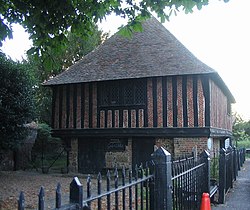 | Kent | 1544 | Grade II* listed (1085670). | |
| Fowey | Fowey Town Hall |  | Cornwall | 1787 | Grade II listed (1290368). | |
| Friern Barnet | Friern Barnet Town Hall |  | Greater London | 1941 | Grade II listed (1360822). Architect: Sir John Brown, A E Henson and Partners. | |
| Fulham | Fulham Town Hall |  | Greater London | 1890 | Grade II* listed (1191939). Architect: George Edwards. | |
| Gainsborough | Gainsborough Town Hall |  | Lincolnshire | 1892 | Architects: Meeke and Bramall. | |
| Garstang | Garstang Town Hall |  | Lancashire | 1764 | Grade II listed (1072906). | |
| Gateshead | Old Town Hall, Gateshead |  | Tyne and Wear | 1870 | Architect: John Johnstone. | |
| Gateshead | Gateshead Civic Centre |  | Tyne and Wear | 1987 | Architect: D W Robson. | |
| Glastonbury | Glastonbury Town Hall | 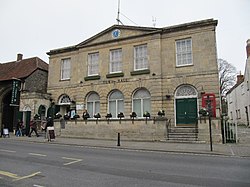 | Somerset | 1814 | Grade II* listed (1057904). Architect: Joseph Beard. | |
| Glossop | Glossop Town Hall |  | Derbyshire | 1838 | Grade II listed (1384269). Architect: Matthew Ellison Hadfield. | |
| Gloucester | Gloucester Guildhall |  | Gloucestershire | 1892 | Grade II listed (1271663). Architect: George H Hunt. | |
| Godalming | Godalming Borough Hall |  | Surrey | 1861 | Architect: Henry Peak. | |
| Godalming | The Pepperpot |  | Surrey | 1814 | Grade II listed (1044496). Architect: John Perry. | |
| Godmanchester | Godmanchester Town Hall |  | Cambridgeshire | 1844 | Grade II listed (1161502). | |
| Gosforth | Gosforth Council Offices |  | Tyne and Wear | 1895 | ||
| Gosport | Gosport Town Hall |  | Hampshire | 1964 | Architects: W. H. Saunders & Son. | |
| Grampound | Grampound Town Hall |  | Cornwall | 1614 | Grade II listed (1144042). | |
| Grantham | Grantham Guildhall |  | Lincolnshire | 1869 | Grade II listed (1360282). Architect: William Watkins of Lincoln. | |
| Grassington | Grassington Town Hall |  | North Yorkshire | 1855 | ||
| Gravesend | Gravesham Civic Centre |  | Kent | 1968 | Architect: Brian Richards. | |
| Gravesend | Gravesend Town Hall |  | Kent | 1764 | Grade II* listed (1054761). Architects: Charles Sloane and Amon Henry Wilds. | |
| Grays | Thurrock Town Hall |  | Essex | 1986 | ||
| Great Dunmow | Old Town Hall, Great Dunmow |  | Essex | 1578 | Grade II listed (1142444). | |
| Great Harwood | Great Harwood Town Hall |  | Lancashire | 1900 | Grade II listed (1206022). Architects: Briggs and Wolstenholme. | |
| Great Malvern | Council House, Malvern |  | Worcestershire | 1880 | Grade II* listed (1156369). Architect: Henry Haddon. | |
| Great Torrington | Great Torrington Town Hall |  | Devon | 1861 | Grade II listed (1332997). | |
| Great Yarmouth | Great Yarmouth Town Hall | 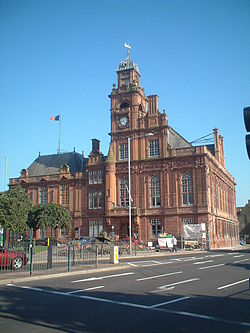 | Norfolk | 1882 | 34 metres (112 ft) | Grade II* listed (1246969). Architect: John Bond Pearce of Norwich. |
| Greenwich | Greenwich Town Hall |  | Greater London | 1939 | 56 metres (184 ft) | Grade II listed (1213855). Architect: Clifford Culpin. |
| Greenwich | Old Town Hall, Greenwich |  | Greater London | 1877 | Architect: William Wallen. | |
| Grimsby | Grimsby Town Hall | 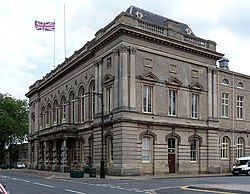 | Lincolnshire | 1863 | Grade II listed (1379888). Architects: Bellamy and Hardy and John Giles. | |
| Guildford | Guildford Guildhall |  | Surrey | 1550 | Grade I listed (1180101). | |
| Guisborough | Guisborough Town Hall |  | North Yorkshire | 1821 | Grade II listed (1329572). | |
| Guiseley | Guiseley Town Hall |  | West Yorkshire | 1867 | Architects: Knowles and Wilcock. | |
| Hackney | Hackney Town Hall |  | Greater London | 1937 | Grade II listed (1235869). Architects: Lanchester and Lodge. | |
| Hackney | Old Town Hall, Hackney |  | Greater London | 1802 | Grade II listed (1226899). | |
| Hadleigh | Hadleigh Town Hall |  | Suffolk | 1851 | Grade II listed (1194514). Architect: William Parkes Ribbans. | |
| Halifax | Halifax Town Hall |  | West Yorkshire | 1863 | 55 metres (180 ft) | Grade II* listed (1314024). Architect: Charles Barry. |
| Haltwhistle | Old Town Hall, Haltwhistle |  | Northumberland | 1861 | Grade II listed (1370315). | |
| Hammersmith | Hammersmith Town Hall |  | Greater London | 1939 | Grade II listed (1079785). Architect: Ernest Berry Webber. | |
| Hampstead | Hampstead Town Hall |  | Greater London | 1878 | Grade II listed (1378818). Architects: Henry Edward Kendall and Frederick Mew. | |
| Handsworth | Old Town Hall, Handsworth |  | West Midlands | 1460 | Grade II listed (1075634). | |
| Handsworth | Council House |  | West Midlands | 1879 | Grade II listed (1221174). Architects: Alexander & Henman of Stockton-on-Tees. | |
| Hanley | Hanley Town Hall |  | Staffordshire | 1869 | Grade II listed (1297932). Architect: Robert Scrivener. | |
| Haringey | Haringey Civic Centre |  | Greater London | 1958 | Grade II listed (1454719). Architect: Sir John Brown, A E Henson and Partners. | |
| Harlow | Harlow Civic Centre |  | Essex | 2004 | ||
| Harpenden | Harpenden Town Hall |  | Hertfordshire | 1994 | ||
| Harrogate | Harrogate Council Offices |  | North Yorkshire | 1931 | Architect: Leonard Clarke. | |
| Harrow | Harrow Civic Centre |  | Greater London | 1973 | Architect: Eric G. Broughton. | |
| Hartlepool (The Headland) | Hartlepool Borough Hall |  | County Durham | 1865 | Grade II listed (1263357). Architect: Charles J. Adams. | |
| Hartlepool | West Hartlepool Town Hall |  | County Durham | 1897 | Grade II listed (1250394). Architect: Henry Cheers. | |
| Harwich | Harwich Guildhall |  | Essex | 1769 | Grade I listed (1298482). | |
| Haslemere | Haslemere Town Hall |  | Surrey | 1814 | Grade II listed (1244092). | |
| Hastings | Hastings Town Hall |  | East Sussex | 1881 | Grade II listed (1245060). Architect: Henry Ward. | |
| Havant | Havant Town Hall |  | Hampshire | 1870 | Architect: Richard William Drew. | |
| Romford | Havering Town Hall |  | Greater London | 1937 | Grade II listed (1245551). Architects: Herbert R. Collins and Antoine Englebert O. Geens. | |
| Hawkshead | Hawkshead Town Hall |  | Cumbria | 1790 | Grade II listed (1121554). Architect: Francis Webster. | |
| Haywards Heath | Haywards Heath Town Hall |  | West Sussex | 1990 | ||
| Heanor | Heanor Town Hall |  | Derbyshire | 1867 | Grade II listed (1158590). | |
| Hebden Bridge | Hebden Bridge Town Hall |  | West Yorkshire | 1898 | Grade II listed (1230338). Architects: Sutcliffe and Sutcliffe. | |
| Hedon | Hedon Town Hall |  | East Riding of Yorkshire | 1693 | Grade II* listed (1083554). | |
| Helmsley | Helmsley Town Hall |  | North Yorkshire | 1901 | Grade II listed (1308328). Architect: Temple Moore. | |
| Helston | Helston Guildhall |  | Cornwall | 1839 | Grade II* listed (1196492). Architect: George Wightwick. | |
| Hemel Hempstead | Old Town Hall, Hemel Hempstead |  | Hertfordshire | 1851 | Grade II listed (1342196). Architect: George Low. | |
| Hendon | Hendon Town Hall | 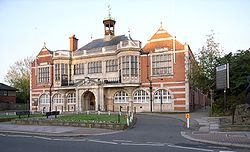 | Greater London | 1901 | Grade II listed (1294762). Architect: Thomas Henry Watson. | |
| Henley-on-Thames | Henley Town Hall |  | Oxfordshire | 1901 | Grade II* listed (1047802). Architect: Henry Hare. | |
| Hereford | Hereford Town Hall |  | Herefordshire | 1904 | Grade II* listed (1279640). Architect: Henry Cheers. | |
| Hessle | Hessle Town Hall |  | East Riding of Yorkshire | 1897 | ||
| Hexham | Hexham Town Hall |  | Northumberland | 1866 | Grade II listed (1042607). Architect: John Johnstone. | |
| Higham Ferrers | Higham Ferrers Town Hall |  | Northampronshire | 1809 | Grade II listed (1371873). | |
| High Wycombe | High Wycombe Guildhall |  | Buckinghamshire | 1757 | Grade II listed (1332349). Architect: Henry Keene. | |
| High Wycombe | High Wycombe Town Hall |  | Buckinghamshire | 1904 | Grade II listed (1246257). Architect: Charles Bateman and Alfred Hale. | |
| High Wycombe | Municipal Offices, High Wycombe |  | Buckinghamshire | 1932 | Architects: Richard Greaves Brocklehurst and Charles Cowles-Voysey. | |
| Hillingdon | Hillingdon Civic Centre |  | Greater London | 1979 | Grade II listed (1451218). Architect: Andrew Derbyshire. | |
| Hinckley | Hinckley Hub |  | Leicestershire | 2013 | Architect: MRP. | |
| Hindley | Hindley Town Hall |  | Greater Manchester | 1903 | Architects: Heaton, Ralph and Heaton. | |
| Hitchin | Hitchin Town Hall |  | Hertfordshire | 1901 | Grade II listed (1394494). Architects: Edward Mountford and Thomas Lucas. | |
| Holborn | Holborn Town Hall |  | Greater London | 1894 | Grade II listed (1378893). Architects: William Rushworth (1894 building) Septimus Warwick and H Austen Hall (1908 extension). | |
| Holmfirth | Holmfirth Civic Hall |  | West Yorkshire | 1842 | Grade II listed (1227986). | |
| Horbury | Horbury Town Hall |  | West Yorkshire | 1903 | Locally listed. Architects: Walter Hanstock & Son. | |
| Horncastle | Horncastle Town Hall |  | Lincolnshire | 1901 | ||
| Hornsea | Hornsea Town Hall |  | East Riding of Yorkshire | 1875 | Architect: John K. James | |
| Hornsey | Hornsey Town Hall |  | Greater London | 1935 | Grade II* listed (1263688). Architect: Reginald Uren. | |
| Horsham | Horsham Town Hall |  | West Sussex | 1812 | Grade II listed (1027519). | |
| Hounslow | Hounslow House |  | Greater London | 2019 | Architects: Sheppard Robson | |
| Hove | Hove Town Hall |  | East Sussex | 1974 | Architect: John Wells-Thorpe. | |
| Hoylake | Hoylake Town Hall | 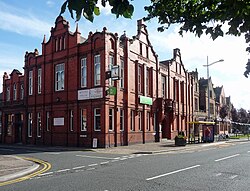 | Merseyside | 1898 | ||
| Hoyland | Hoyland Town Hall |  | South Yorkshire | 1972 | ||
| Huddersfield | Huddersfield Town Hall |  | West Yorkshire | 1881 | Grade II listed (1231723). Architect: John Henry Abbey. | |
| Hugh Town | Isles of Scilly Town Hall |  | Cornwall | 1889 | Grade II listed (1219066) Architect: J. Goodfellow. | |
| Kingston upon Hull | Hull City Hall |  | East Riding of Yorkshire | 1909 | Grade II* listed (1197685). Architect: Joseph Hirst. | |
| Kingston upon Hull | Hull Guildhall |  | East Riding of Yorkshire | 1914 | 41 metres (135 ft) | Grade II* listed (1279708). Architect: Edwin Cooper. |
| Hungerford | Hungerford Town Hall |  | Berkshire | 1871 | Grade II listed (1210595). Architect: John Money. | |
| Hunstanton | Hunstanton Town Hall |  | Norfolk | 1896 | Grade II listed (1171478). Architect: George Skipper. | |
| Huntingdon | Huntingdon Town Hall |  | Cambridgeshire | 1745 | Grade II* listed (1128584). Architect: Benjamin Timbrell. | |
| Huyton | Huyton Municipal Building | 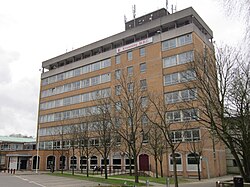 | Merseyside | 1963 | Architect: Henry Kay Pilkinton. | |
| Hyde | Hyde Town Hall |  | Greater Manchester | 1885 | Grade II listed (1393594). Architect: James William Beaumont. | |
| Hythe | Hythe Town Hall |  | Kent | 1794 | Grade II* listed (1068981). Architect: William Tritton. | |
| Ilchester | Ilchester Town Hall |  | Somerset | 1816 | Grade II listed (1057301). | |
| Ilfracombe | Old Town Hall, Ilfracombe |  | Devon | 1862 | Grade II listed (1293104). | |
| Ilkeston | Ilkeston Town Hall |  | Derbyshire | 1868 | Grade II listed (1280610). Architect: Richard Charles Sutton. | |
| Ilkley | Ilkley Town Hall |  | West Yorkshire | 1908 | Grade II listed (1314237). Architect: William Bakewell. | |
| Ince-in-Makerfield | Ince-in-Makerfield Town Hall |  | Greater Manchester | 1903 | Architects: Heaton, Ralph and Heaton. | |
| Ipswich | Ipswich Town Hall |  | Suffolk | 1868 | Grade II listed (1206572). Now an arts centre and events venue. Architects: Bellamy and Hardy of Lincoln. | |
| Islington | Islington Town Hall | 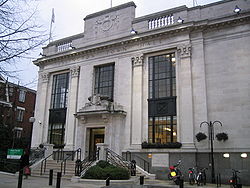 | Greater London | 1930 | Grade II listed (1297950). Architect: E.C.P. Monson. | |
| Ivybridge | Ivybridge Town Hall |  | Devon | 1995 | ||
| Jarrow | Jarrow Town Hall | 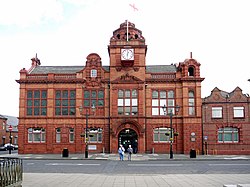 | Tyne and Wear | 1904 | Grade II listed (1299416). Architect: Fred Rennoldson. | |
| Keighley | Keighley Town Hall |  | West Yorkshire | 1902 | Grade II listed (1134150). Architect: John Haggas. | |
| Kendal | Kendal Town Hall |  | Cumbria | 1827 | Grade II listed (1318980). Architect: Francis Webster. | |
| Kensington | Kensington Town Hall | 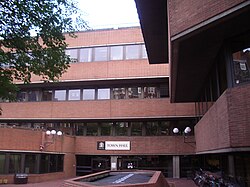 | Greater London | 1976 | Architect: Sir Basil Spence. | |
| Keswick | The Moot Hall |  | Cumbria | 1813 | Grade II* listed (1137345). | |
| Kettering | Kettering Municipal Offices |  | Northamptonshire | 1913 | Architect: John Alfred Gotch. | |
| Keynsham | Keynsham Civic Centre |  | Somerset | 2015 | Architect: AHR. | |
| Kidderminster | Kidderminster Town Hall |  | Worcestershire | 1877 | Grade II listed (1348650). Architect: J. T. Meredith. | |
| Kidsgrove | Kidsgrove Town Hall |  | Staffordshire | 1898 | Locally listed. Architects: Wood and Hutchings. | |
| Kingsbridge | Kingsbridge Town Hall |  | Devon | 1850 | Grade II listed (1107527). | |
| King's Lynn | King's Lynn Guildhall |  | Norfolk | 1428 | Grade I listed (1211953). | |
| Kingston upon Thames | Kingston upon Thames Guildhall |  | Greater London | 1935 | Grade II listed (1080065). Architect: Maurice Webb. | |
| Kington | Kington Town Hall |  | Herefordshire | 1820 | Grade II listed (1297574, 1208453 and 1293133). Architect: Benjamin Wishlade. | |
| Kirkburton | Kirkburton Town Hall |  | West Yorkshire | 1835 | Grade II listed (1135339). | |
| Kirton in Holland | Kirton in Holland Town Hall |  | Lincolnshire | 1912 | Architect: Henry Kidd. | |
| Kirton in Lindsey | Kirton in Lindsey Town Hall |  | Lincolnshire | 1899 | Grade II listed (1160694). Architect: J. K. Broughton. | |
| Knaresborough | Old Town Hall, Knaresborough |  | North Yorkshire | 1862 | Grade II listed (1315653). Architect: John Child. | |
| Knottingley | Knottingley Town Hall |  | West Yorkshire | 1865 | Architect: Shaw and Weightman. | |
| Knutsford | Knutsford Town Hall |  | Cheshire | 1871 | Grade II listed (1378496). Architect: Alfred Waterhouse. | |
| Lambeth | Lambeth Town Hall | 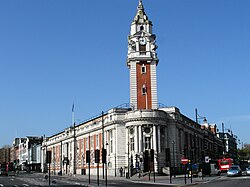 | Greater London | 1908 | 41 metres (135 ft) | Grade II listed (1080534). Architects: Septimus Warwick and H. Austen Hall. |
| Lambeth | Old Town Hall, Kennington Road | 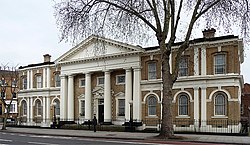 | Greater London | 1853 | Grade II listed (1080399). Architects: Raymond Willshire and Robert Parris. | |
| Lancaster | Lancaster Town Hall | 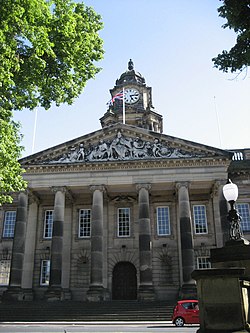 | Lancashire | 1909 | Grade II* listed (1194923). Architects: Edward Mountford and Thomas Lucas. | |
| Lancaster | Old Town Hall, Lancaster |  | Lancashire | 1783 | 55 metres (180 ft) | Grade II* listed (1194971). Architect: Major Jarrett. |
| Langport | Langport Town Hall |  | Somerset | 1732 | Grade II listed (1056610). | |
| Launceston | Launceston Guildhall and Town Hall |  | Cornwall | 1887 | Grade II listed (1297841). Architects: Otho B. Peter and G. Hine. | |
| Leamington Spa | Leamington Spa Town Hall |  | Warwickshire | 1884 | 44 metres (144 ft) | Grade II listed (1381441). Architect: John Cundall. |
| Leatherhead | Council Offices |  | Surrey | 1935 | Grade II listed (1113328). Architects: C. H. Rose and H. R. Gardner. | |
| Ledbury | Ledbury Town Hall |  | Herefordshire | 1617 | Grade I listed (1349392). Architect: John Abel. | |
| Leeds | Leeds Civic Hall |  | West Yorkshire | 1933 | 52 metres (171 ft) | Grade II* listed (1255781). Architect: Vincent Harris. |
| Leeds | Leeds Town Hall |  | West Yorkshire | 1858 | 69 metres (226 ft) | Grade I listed (1255772). Architect: Cuthbert Brodrick of Hull. |
| Leicester | Leicester Guildhall |  | Leicestershire | 1390 | Grade I listed (1361405). Now a museum and performance venue. | |
| Leicester | Leicester Town Hall |  | Leicestershire | 1876 | 44 metres (144 ft) | Grade II* listed (1074780). Architect: Francis Hames. |
| Leicester | City Hall, Leicester |  | Leicestershire | 1938 | Locally listed. Architects: Leonard Barnish and Spencer Silcock. | |
| Leigh | Leigh Town Hall |  | Greater Manchester | 1907 | Grade II listed (1163007). Architect: James Caldwell Prestwich. | |
| Leighton Buzzard | Old Town Hall, Leighton Buzzard |  | Bedfordshire | 1851 | Grade II listed (1114566). | |
| Letchworth | Letchworth Town Hall |  | Hertfordshire | 1935 | Grade II listed (1393610). Architects: Robert Bennett and Wilson Bidwell. | |
| Levenshulme | Levenshulme Town Hall |  | Greater Manchester | 1899 | Architect: James Jepson. | |
| Lewes | Lewes Town Hall |  | East Sussex | 1893 | Grade II listed (1353072). Architect: Samuel Denman. | |
| Lewisham | Lewisham Town Hall |  | Greater London | 1932 | Grade II listed (1253065). Architect: Bradshaw Gass & Hope. | |
| Leyburn | Leyburn Town Hall |  | North Yorkshire | 1857 | Grade II listed (1178994). | |
| Leyton | Leyton Town Hall |  | Greater London | 1895 | Grade II listed (1065587). Architect: John Johnson. | |
| Lichfield | Lichfield Guildhall |  | Staffordshire | 1848 | Grade II listed (1187740). Architect: Joseph Potter Jnr. | |
| Limehouse | Limehouse Town Hall |  | Greater London | 1881 | Grade II listed (1240047). Architects: Arthur and Christopher Harston. | |
| Lincoln | Lincoln Guildhall |  | Lincolnshire | 1520 | Grade I listed (1388605) | |
| Lincoln | Lincoln City Hall |  | Lincolnshire | 1973 | Architects: John Roberts Associates. | |
| Liskeard | Liskeard Guildhall |  | Cornwall | 1858 | Grade II listed (1206610) Architects: Charles Reeves and Lewis George Butcher. | |
| Litherland | Litherland Town Hall |  | Merseyside | 1940 | Architect: Gerald de Courcy Fraser. | |
| Little Bolton | Little Bolton Town Hall |  | Greater Manchester | 1828 | Grade II listed (1388257). Architects: John Thompson. | |
| Liverpool | Liverpool Town Hall |  | Merseyside | 1754 | 32 metres (105 ft) | Grade I listed (1360219). Architect: John Wood the Elder of Bath. |
| Liverpool | Municipal Buildings |  | Merseyside | 1868 | 61 metres (200 ft) | Grade II* listed (1068281). Architect: John Weightman; completed by ER Robson. |
| Liversedge | Liversedge Town Hall |  | West Yorkshire | 1880 | Architect: William Ellis. | |
| Lockwood | Lockwood Town Hall |  | West Yorkshire | 1866 | Grade II listed (1239516). | |
| Loddon | Old Town Hall, Loddon |  | Norfolk | 1870 | Grade II listed (1169370). | |
| Loftus | Loftus Town Hall |  | North Yorkshire | 1879 | Grade II listed (1136562). Architect: Edward Robert Robson. | |
| Long Eaton | Long Eaton Town Hall | 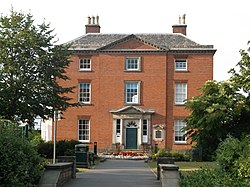 | Derbyshire | 1778 | Grade II* listed (1204191). Architect: Joseph Pickford. | |
| Longton | Longton Town Hall |  | Staffordshire | 1844 | Grade II listed (1297944). Architect: John Burrill. | |
| Looe | Looe Guildhall |  | Cornwall | 1877 | 27 metres (89 ft) | Grade II listed (1280863). Architect: John Ford Gould. |
| Looe | The Old Guildhall |  | Cornwall | 1450 | Grade II* listed (1201113). | |
| Lostwithiel | Lostwithiel Guildhall | 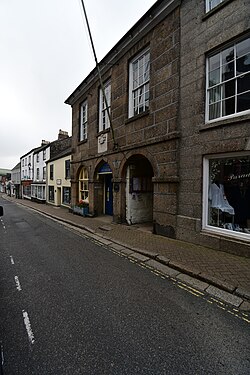 | Cornwall | 1740 | Grade II listed (1144227) | |
| Loughborough | Loughborough Town Hall |  | Leicestershire | 1855 | Grade II listed (1361164). Architect: William Slater. | |
| Louth | Louth Town Hall |  | Lincolnshire | 1854 | Grade II listed (1063257). Architect: Pearson Bellamy. | |
| Lowestoft | Lowestoft Town Hall |  | Suffolk | 1860 | Grade II listed (1279943). Architect: John Louth Clemence. | |
| Ludlow | Ludlow Guildhall |  | Shropshire | 1411 | Grade I listed (1211188). | |
| Luton | Luton Town Hall |  | Bedfordshire | 1936 | 44 metres (144 ft) | Grade II listed (1376193). Architects: Bradshaw Gass & Hope. |
| Lutterworth | Lutterworth Town Hall |  | Leicestershire | 1836 | Grade II listed (1211129). Architect: Joseph Hansom. | |
| Lydd | Lydd Guildhall |  | Kent | 1792 | Grade II listed (1338208). | |
| Lydney | Lydney Town Hall |  | Gloucestershire | 1889 | Locally listed. Architect: William Howard Seth-Smith | |
| Lyme Regis | Lyme Regis Guildhall |  | Dorset | 1889 | Grade II* listed (1228691). Architect: George Vialls. | |
| Lynton | Lynton Town Hall |  | Devon | 1900 | Grade II listed (1206608). Architects: Read and Macdonald. | |
| Lytham St Annes | Lytham St Annes Town Hall |  | Lancashire | 1898 | Locally listed. | |
| Macclesfield | Macclesfield Town Hall |  | Cheshire | 1824 | Grade II* listed (1206935). Architect: Francis Goodwin of Norfolk. | |
| Maidenhead | Maidenhead Town Hall | 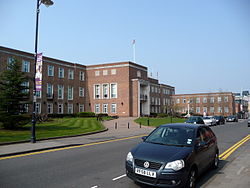 | Berkshire | 1962 | Architects: North & Partners and Sir Hubert Worthington | |
| Maidstone | Maidstone Town Hall |  | Kent | 1763 | Grade II* listed (1086305). | |
| Maldon | The Moot Hall |  | Essex | 1420 | Grade I listed (1256887). | |
| Malmesbury | Malmesbury Town Hall |  | Wiltshire | 1854 | Grade II listed (1269481). | |
| Malton | Malton Town Hall |  | North Yorkshire | 1749 | Grade II listed (1282440). | |
| Manchester | Manchester Town Hall | 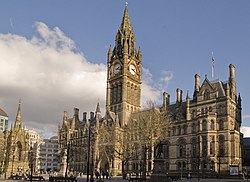 | Greater Manchester | 1877 | 85 metres (279 ft) | Grade I listed (1207469). Architect: Alfred Waterhouse. |
| Manchester | Manchester Town Hall Extension |  | Greater Manchester | 1938 | Grade II* listed (1197917). Architect: Vincent Harris. | |
| Mansfield | Old Town Hall, Mansfield |  | Nottinghamshire | 1836 | Grade II* listed (1207179). Architect: William Adams Nicholson. | |
| Marazion | Marazion Town Hall |  | Cornwall | 1871 | Grade II listed (1327585). | |
| March | March Town Hall |  | Cambridgeshire | 1900 | 33.5 metres (110 ft) | Grade II listed (1216349). Architect: W. T. Unwin. |
| Margate | Margate Town Hall |  | Kent | 1898 | Grade II listed (1351074). | |
| Market Deeping | Market Deeping Town Hall |  | Lincolnshire | 1835 | Grade II listed (1317350). Architect: Thomas Pilkington. | |
| Market Harborough | Market Harborough Town Hall |  | Leicestershire | 1788 | Grade II listed (1074426). | |
| Marlborough | Marlborough Town Hall |  | Wiltshire | 1902 | Grade II listed (1242852). Architect: Charles Ponting. | |
| Marlow | Marlow Town Hall |  | Buckinghamshire | 1807 | Grade II* listed (1159570). Architect: Samuel Wyatt. | |
| Martock | Martock Town Hall |  | Somerset | 1785 | Grade II listed (1225758). | |
| Marylebone | Marylebone Town Hall |  | Greater London | 1920 | Grade II* listed (1222688). Architect: Sir Edwin Cooper. | |
| Masham | Masham Town Hall |  | North Yorkshire | 1913 | Grade II listed (1167212). Architect: John Houfe. | |
| Matlock | Matlock Town Hall |  | Derbyshire | 1850 | ||
| Melksham | Melksham Town Hall |  | Wiltshire | 1847 | Grade II listed (1194263). Architect: D. Jones. | |
| Meltham | Meltham Town Hall |  | West Yorkshire | 1898 | Architect: William Carter. | |
| Morden | Merton Civic Centre |  | Greater London | 1960 | 49 metres (161 ft) | Architect: A. Green. |
| Middlesbrough | Middlesbrough Town Hall |  | North Yorkshire | 1889 | 52 metres (171 ft) | Grade II* listed (1136659). Architect: GG Hoskins. |
| Middlesbrough | Old Town Hall, Middlesbrough |  | North Yorkshire | 1846 | Grade II listed (1139853). Architect: William Lambie Moffatt of Doncaster. | |
| Middleton | Middleton Town Hall |  | Greater Manchester | 1965 | Architect: Tom Ellis of Lyons Israel Ellis. | |
| Middlewich | Middlewich Town Hall |  | Cheshire | 1898 | ||
| Midhurst | Old Town Hall, Midhurst |  | West Sussex | 1551 | Grade II listed (1234718). | |
| Midsomer Norton | Midsomer Norton Town Hall |  | Somerset | 1860 | Grade II listed (1115167). Architect: Foster and Wood. | |
| Milborne Port | Milborne Port Town Hall |  | Somerset | 1720 | Grade II listed (1174867). | |
| Millom | Old Town Hall, Millom |  | Cumbria | 1879 | ||
| Milnrow | Milnrow Town Hall |  | Greater Manchester | 1888 | ||
| Milton Keynes | Milton Keynes Civic Offices |  | Buckinghamshire | 1979 | Architect: Faulkner Brown Hendy Watkinson Stonor. | |
| Minehead | Minehead Town Hall |  | Somerset | 1902 | Grade II listed (1279928). Architect: William John Tamlyn. | |
| Mirfield | Mirfield Town Hall |  | West Yorkshire | 1868 | Architects: Kirk and Sons. | |
| Mitcham | Mitcham Town Hall |  | Greater London | 1887 | Architect: Robert Masters Chart. | |
| Mitcheldean | Mitcheldean Town Hall |  | Gloucestershire | 1710 | Grade II listed (1299149). | |
| Morecambe | Morecambe Town Hall |  | Lancashire | 1932 | Grade II listed (1389539). Architects: Alfred Cross and Kenneth Cross. | |
| Morley | Morley Town Hall |  | West Yorkshire | 1895 | 49 metres (161 ft) | Grade I listed (1135112). Architects: Henry Holtom and George Arthur Fox. |
| Morpeth | Morpeth Town Hall | 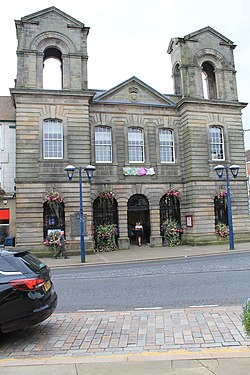 | Northumberland | 1714 | Grade II listed (1042730). Architect: John Vanbrugh. | |
| Moreton-in-Marsh | Moreton-in-Marsh Town Hall |  | Gloucestershire | 1887 | Grade II listed (1088683). Architects: Sir Ernest George and Harold Peto | |
| Mossley | Mossley Town Hall |  | Greater Manchester | 1864 | Grade II listed (1068044). Architect: William Williamson. | |
| Much Wenlock | Much Wenlock Guildhall |  | Shropshire | 1557 | Grade II* listed (1053794) | |
| Nailsworth | Nailsworth Town Hall | 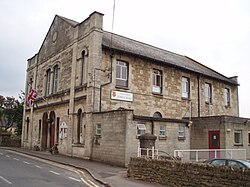 | Gloucestershire | 1868 | ||
| Needham Market | Old Town Hall, Needham Market |  | Suffolk | 1866 | Grade II listed (1253656). Architect: Frederick Barnes. | |
| Nelson | Nelson Town Hall |  | Lancashire | 1881 | Architect: Alfred Waterhouse. | |
| Neston | Neston Town Hall |  | Cheshire | 1889 | Architect: David Walker. | |
| Newark-on-Trent | Newark Town Hall |  | Nottinghamshire | 1776 | Grade I listed (1196430). Architect: John Carr. | |
| New Bolingbroke | New Bolingbroke Town Hall |  | Lincolnshire | 1823 | Grade II listed (1063565). | |
| Newbrough | Newbrough Town Hall |  | Northumberland | 1878 | Grade II listed (1303483). | |
| Newburn | Newburn Town Hall |  | Tyne and Wear | 1910 | Grade II listed (1186074). Architect: Edward Cratney. | |
| Newbury | Newbury Town Hall |  | Berkshire | 1881 | Grade II listed (1210586). Architect: James H. Money. | |
| Newcastle-under-Lyme | Newcastle-under-Lyme Guildhall |  | Staffordshire | 1713 | Grade II listed (1196523). | |
| Newcastle upon Tyne | Newcastle Civic Centre |  | Tyne and Wear | 1967 | 61 metres (200 ft) | Grade II* listed (1242692). Architect: George Kenyon. |
| Newcastle upon Tyne | Newcastle Guildhall |  | Tyne and Wear | 1655 | Grade I listed (1120877). Architect: Robert Trollope. | |
| East Ham | Newham Town Hall | 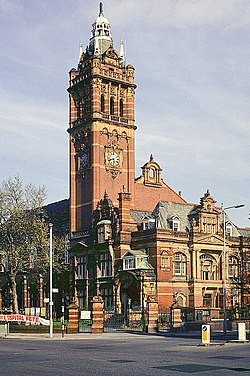 | Greater London | 1903 | 46 metres (151 ft) | Grade II* listed (1190712). Architect: Henry Cheers and Joseph Smith. |
| New Malden | New Malden Town Hall |  | Greater London | 1905 | Architect: William Horace Pope. | |
| Newmarket | Newmarket Town Hall |  | Suffolk | 1830 | Grade II listed (1351290). | |
| New Mills | New Mills Town Hall |  | Derbyshire | 1871 | ||
| New Milton | New Milton Town Hall |  | Hampshire | 2003 | ||
| Newport | Newport Town Hall |  | Cornwall | 1829 | Grade II listed (1195995). | |
| Newport | Newport Guildhall |  | Isle of Wight | 1816 | Grade II* listed (1278563). Architect: John Nash. | |
| Newport | Old Town Hall, Newport |  | Shropshire | 1860 | Grade II listed (1367292). Architect: John Cobb Jr. | |
| Newport | Newport Guildhall |  | Shropshire | 1400 | Grade II* listed (1177807). | |
| Newport Pagnell | Old Town Hall Chambers |  | Buckinghamshire | 1845 | Grade II listed (1309947). Architect: Richard Sheppard. | |
| New Romney | New Romney Town Hall |  | Kent | 1702 | Grade II listed (1068989). | |
| Newton Abbot | Old Town Hall, Newton Abbot |  | Devon | 1862 | Grade II listed (1257148). | |
| Newtown | Old Town Hall, Newtown |  | Isle of Wight | 1699 | Grade II* listed (1209336). | |
| Northallerton | Northallerton Town Hall |  | North Yorkshire | 1873 | Grade II listed (1389344). Architects: John Ross and Robert Lamb. | |
| Northampton | Northampton Guildhall |  | Northamptonshire | 1864 | Grade II* listed (1052399). Architect: Edward William Godwin of London. | |
| North Tawton | North Tawton Town Hall |  | Devon | 1849 | Grade II listed (1105310). | |
| Norwich | Norwich City Hall |  | Norfolk | 1938 | 56 metres (184 ft) | Grade II* listed (1210484). Architects: Charles Holloway James and Stephen Rowland Pierce. |
| Norwich | Norwich Guildhall |  | Norfolk | 1413 | Grade I listed (1187384). | |
| Nottingham | Nottingham Council House |  | Nottinghamshire | 1929 | 61 metres (200 ft) | Grade II* listed (1270582). Architect: Thomas Cecil Howitt. |
| Nuneaton | Nuneaton Town Hall |  | Warwickshire | 1934 | Architects: Peacock & Bewley of Birmingham. | |
| Oakengates | Oakengates Town Hall |  | Shropshire | 1968 | Architect: Maurice Day. | |
| Okehampton | Okehampton Town Hall |  | Devon | 1685 | Grade II* listed (1105855). | |
| Oldbury | Municipal Buildings |  | West Midlands | 1891 | Architects: Wood and Kendrick of West Bromwich. | |
| Oldham | Old Town Hall, Oldham |  | Greater Manchester | 1841 | Grade II listed (1201655). Architect: George Woodhouse. | |
| Oldham | Oldham Civic Centre |  | Greater Manchester | 1977 | 53 metres (174 ft) | Architect: Cecil Howitt & Partners. |
| Orford | Orford Town Hall |  | Suffolk | 1902 | Grade II listed (1198392). Architects: Harry Sirr and Edwin Rope. | |
| Ormskirk | Old Town Hall, Ormskirk |  | Lancashire | 1779 | Grade II listed (1297311). | |
| Ossett | Ossett Town Hall |  | West Yorkshire | 1908 | Grade II listed (1184149). Architects: Walter Hanstock & Son. | |
| Oswaldtwistle | Oswaldtwistle Town Hall |  | Lancashire | 1891 | Architect: Robert Naisbitt Hunter. | |
| Oswestry | Oswestry Guildhall |  | Shropshire | 1893 | Grade II listed (1367321). Architect: Henry Cheers. | |
| Otley | Otley Civic Centre |  | West Yorkshire | 1871 | Grade II listed (1200204). Architect: Charles Fowler. | |
| Ottery St Mary | Old Town Hall, Ottery St Mary |  | Devon | 1859 | ||
| Oundle | Old Town Hall, Oundle |  | Northamptonshire | 1830 | Grade II listed (1372119). | |
| Oxford | Oxford Town Hall |  | Oxfordshire | 1897 | Grade II* listed (1047153). Architect: Henry Hare. | |
| Padiham | Padiham Town Hall |  | Lancashire | 1938 | Grade II listed (1237652). Architect: Bradshaw Gass & Hope. | |
| Paignton | Old Town Hall, Paignton |  | Devon | 1870 | Architect: John Tarring. | |
| Painswick | Painswick Town Hall |  | Gloucestershire | 1840 | Grade II listed (1091564). | |
| Penistone | Penistone Town Hall |  | South Yorkshire | 1914 | Architect: Henry R. Collins. | |
| Penrith | Penrith Town Hall |  | Cumbria | 1906 | Grade II listed (1420806). Architect: J. J. Knewstub. | |
| Penryn | Penryn Town Hall |  | Cornwall | 1839 | Grade II* listed (1280314). | |
| Penzance | The Public Buildings |  | Cornwall | 1867 | Grade II listed (1143145). Architect: John Matthews. | |
| Pershore | Pershore Civic Centre |  | Worcestershire | 1991 | ||
| Pershore | Pershore Town Hall |  | Worcestershire | 1932 | Architect: Henry Seccombe. | |
| Pershore | Old Council Offices, Pershore |  | Worcestershire | 1800 | Grade II* listed (1387076). | |
| Peterborough | Peterborough Town Hall | 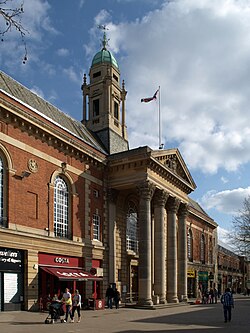 | Cambridgeshire | 1933 | Architect: Ernest Berry Webber. | |
| Peterborough | Peterborough Guildhall |  | Cambridgeshire | 1671 | Grade II* listed (1126990). Architect: John Lovin. | |
| Petersfield | Petersfield Festival Hall and Town Hall |  | Hampshire | 1935 | Architects: Seely & Paget. | |
| Petworth | Petworth Town Hall |  | West Sussex | 1793 | Grade II* listed (1225590). | |
| Pevensey | Pevensey Town Hall |  | East Sussex | 1540 | Grade II listed (1182588). | |
| Pickering | Pickering Memorial Hall |  | North Yorkshire | 1865 | Grade II listed (1260382). | |
| Plymouth | Plymouth Civic Centre |  | Devon | 1962 | Grade II listed (1392038). Architect: Jellicoe, Ballantyne & Colleridge. | |
| Plymouth | Plymouth Guildhall | 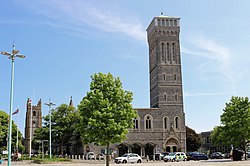 | Devon | 1874 | 50 metres (164 ft) | Grade II listed (1113280). Architects: Norman and Hine. |
| Plympton | Plympton Guildhall |  | Devon | 1688 | Grade II* listed (1244435). | |
| Pontefract | Pontefract Town Hall |  | West Yorkshire | 1882 | Grade II listed (1184866). Architects: Henry Perkin and George Bertram Bulmer. | |
| Pontefract | Old Town Hall, Pontefract |  | West Yorkshire | 1785 | Grade II listed (1299877). Architect: Bernard Hartley I. | |
| Poole | Poole Civic Centre |  | Dorset | 1932 | Grade II listed (1465200). Architect: L. Magnus Austin. | |
| Poole | Poole Guildhall |  | Dorset | 1761 | Grade II* listed (1266739). | |
| Poplar | Poplar Town Hall |  | Greater London | 1938 | Grade II listed (1393151). Architects: Culpin and Son. | |
| Poplar | Old Town Hall, Poplar |  | Greater London | 1870 | Grade II listed (1260135). Architects: Walter Augustus Hills and Thomas Wayland Fletcher with Arthur and Christopher Harston. | |
| Portslade | Portslade Town Hall |  | East Sussex | 1928 | Locally listed. Architect: Gilbert Murray Simpson. | |
| Portsmouth | Portsmouth Civic Offices | 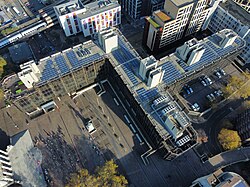 | Hampshire | 1976 | Architects: Harry Teggin and David Taylor. | |
| Portsmouth | Portsmouth Guildhall |  | Hampshire | 1890 | 54 metres (177 ft) | Grade II listed (1104316). Architect: William Hill of Leeds. |
| Poulton-le-Fylde | Old Town Hall |  | Lancashire | 1910 | ||
| Prescot | Prescot Town Hall |  | Merseyside | 2014 | ||
| Preston | Preston Town Hall |  | Lancashire | 1934 | Grade II listed (1207297). Architect: Sir Arnold Thornely. | |
| Pudsey | Pudsey Town Hall |  | West Yorkshire | 1880 | Architects: Hope and Jardine. | |
| Purley | Purley Council Offices |  | Greater London | 1930 | Grade II listed (1063902). Architects: W. B. Nicholls and Basil Hughes. | |
| Queenborough | Queenborough Guildhall |  | Kent | 1793 | Grade II listed (1258419). | |
| Radcliffe | Radcliffe Town Hall |  | Greater Manchester | 1911 | Locally listed. Architects: W. M. Gillow and R. Holt. | |
| Rawtenstall | Rawtenstall Town Hall |  | Lancashire | 1876 | Locally listed. | |
| Reading | Reading Town Hall |  | Berkshire | 1875 | 50 metres (164 ft) | Grade II* listed (1113400). Architect: Alfred Waterhouse. |
| Ilford | Redbridge Town Hall |  | Greater London | 1901 | Grade II listed (1390560). Architect: Ben Woollard. | |
| Redditch | Redditch Town Hall |  | Worcestershire | 1982 | Architect: Cassidy & Ashton Partners. | |
| Redruth | Old Town Hall, Redruth |  | Cornwall | 1850 | Grade II listed (1142565). Architect: Robert Blee. | |
| Reepham | Reepham Town Hall |  | Norfolk | 1860 | ||
| Reigate | Reigate Town Hall |  | Surrey | 1901 | Grade II listed (1260489). Architects: Macintosh and Newman. | |
| Reigate | Old Town Hall, Reigate |  | Surrey | 1728 | Grade II* listed (1188608). | |
| Retford | Retford Town Hall |  | Nottinghamshire | 1868 | Grade II listed (1370374). Architects: Bellamy and Hardy. | |
| Richmond | Richmond Town Hall | 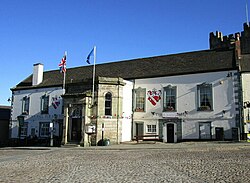 | North Yorkshire | 1756 | Grade II listed (1240517). Architect: Thomas Atkinson. | |
| Richmond upon Thames | Old Town Hall, Richmond | 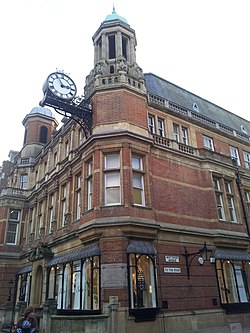 | Greater London | 1893 | Now the Museum of Richmond, library and art gallery. | |
| Rickmansworth | Old Town Hall, Rickmansworth |  | Hertfordshire | 1869 | Architect: Arthur Allum. | |
| Ripley, Derbyshire | Ripley Town Hall |  | Derbyshire | 1881 | Architect: George Eyre. | |
| Ripley, North Yorkshire | Ripley Town Hall |  | North Yorkshire | 1854 | Grade II listed (1174009). | |
| Ripon | Ripon Town Hall |  | North Yorkshire | 1799 | Grade II* listed (1174370). Architect: James Wyatt. | |
| Rochdale | Rochdale Town Hall |  | Greater Manchester | 1871 | 58 metres (190 ft) | Grade I listed (1084275). Architects: William Henry Crossland and Alfred Waterhouse. |
| Rochester | Rochester Guildhall |  | Kent | 1697 | Grade I listed (1186145). | |
| Romsey | Romsey Town Hall |  | Hampshire | 1866 | Architect: Alfred Bedborough. | |
| Rotherham | Rotherham Town Hall |  | South Yorkshire | 1929 | ||
| Rothwell | Rothwell Market House |  | Northamptonshire | 1578 | Grade I listed (1288812). Architect: John Thorpe. | |
| Rothwell | Rothwell Town Hall |  | West Yorkshire | 1895 | Architects: T. H. and W. E. Richardson. | |
| Royston | Royston Town Hall |  | Hertfordshire | 1855 | Locally listed. | |
| Royton | Royton Town Hall |  | Greater Manchester | 1880 | ||
| Rugby | Rugby Town Hall |  | Warwickshire | 1961 | Architect: Ernest Prestwich. | |
| Runcorn | Runcorn Town Hall |  | Cheshire | 1856 | Grade II listed (1104859). Architect: Charles Verelst. | |
| Rushden | Council Buildings |  | Northamptonshire | 1906 | Locally listed. Architect: William Madin. | |
| Ryde | Ryde Town Hall |  | Isle of Wight | 1831 | Grade II listed (1217046). Architect: James Sanderson. | |
| Rye | Rye Town Hall |  | East Sussex | 1743 | Grade II* listed (1251881). Architect: Andrew Jelfe. | |
| Saffron Walden | Saffron Walden Town Hall |  | Essex | 1763 | Grade II listed (1196219). Architect: Edward Burgess. | |
| Sale | Sale Town Hall |  | Greater Manchester | 1915 | ||
| Salford | Salford Civic Centre |  | Greater Manchester | 1938 | 38 metres (125 ft) | Formerly Swinton Town Hall. Architects: Percy Thomas and Ernest Prestwich. |
| Salford | Salford Town Hall |  | Greater Manchester | 1827 | Grade II listed (1386076). Architect: Richard Lane. | |
| Salisbury | Salisbury Guildhall |  | Wiltshire | 1795 | Grade II* listed (1242739). Architects: Sir Robert Taylor and William Pilkington. | |
| Saltash | Saltash Guildhall |  | Cornwall | 1780 | Grade II listed (1140371). | |
| Sandbach | Sandbach Town Hall |  | Cheshire | 1890 | Grade II listed (1130352). Architect: Thomas Bower. | |
| Sandown | Sandown Town Hall |  | Isle of Wight | 1869 | Grade II listed (1034283). Architect: Thomas Dowell. | |
| Sandwich | Sandwich Guildhall | 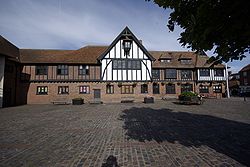 | Kent | 1579 | Grade II* listed (1069731). | |
| Sandy | Sandy Town Hall |  | Bedfordshire | 1906 | Architect: Alfred Ernest Anthony. | |
| Scarborough | Scarborough Town Hall |  | North Yorkshire | 1844 | Grade II listed (1273023). Originally built as a private home; converted to town hall in 1898–1903. Architect: Henry Wyatt or W B Stewart. | |
| Scunthorpe | Scunthorpe Civic Centre |  | Lincolnshire | 1962 | Grade II listed (1323702). Architects: Charles B. Pearson and Partners. | |
| Seaford | Old Town Hall, Seaford |  | East Sussex | 1562 | Grade II listed (1252581). | |
| Seaton | Seaton Town Hall |  | Devon | 1904 | ||
| Selby | Selby Town Hall |  | North Yorkshire | 1862 | ||
| Settle | Settle Town Hall |  | North Yorkshire | 1832 | Grade II listed (1132346). Architect: George Webster. | |
| Shaftesbury | Shaftesbury Town Hall |  | Dorset | 1837 | Grade II listed (1108741). | |
| Shanklin | Shanklin Town Hall |  | Isle of Wight | 1878 | Grade II listed (1393657). Architect: E. G. Cooper. | |
| Sheffield | Sheffield Town Hall |  | South Yorkshire | 1897 | 61 metres (200 ft) | Grade I listed (1246902). Architect: Edward William Mountford of London. |
| Sheffield | Sheffield Old Town Hall |  | South Yorkshire | 1808 | Grade II listed (1247500). Architect: Charles Watson of Wakefield. | |
| Sheffield | Sheffield City Hall |  | South Yorkshire | 1932 | Grade II* listed (1246548). Architect: Vincent Harris. | |
| Sheringham | Sheringham Town Hall |  | Norfolk | 1912 | Architects: Stanley Simons & Co. | |
| Shipley | Shipley Town Hall |  | West Yorkshire | 1932 | ||
| Shoreditch | Shoreditch Town Hall |  | Greater London | 1866 | Grade II listed (1235232). Architect: Caesar Augustus Long. | |
| Shoreham-by-Sea | Shoreham Town Hall |  | West Sussex | 1830 | Grade II listed (1027866). Architect: Sydney Smirke. | |
| Shrewsbury | Old Guildhall, Shrewsbury |  | Shropshire | 1696 | Grade II* listed (1270999). | |
| Silsden | Silsden Town Hall |  | West Yorkshire | 1894 | ||
| Skegness | Skegness Town Hall |  | Lincolnshire | 1926 | Grade II listed (1474562). Architect: William Henry Ansell. | |
| Skipton | Skipton Town Hall |  | North Yorkshire | 1862 | Grade II listed (1301634). | |
| Slaithwaite | Slaithwaite Town Hall | 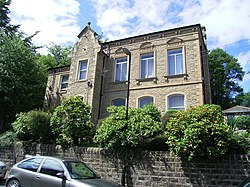 | West Yorkshire | 1892 | Architect: James B. Eagland. | |
| Slough | Slough Town Hall |  | Berkshire | 1937 | Architects: Charles Holloway James and Stephen Rowland Pierce. | |
| Smethwick | Smethwick Council House |  | West Midlands | 1907 | Grade II listed (1342665). Architect: Frederick J. Gill. | |
| Solihull | Old Council House, Solihull |  | West Midlands | 1876 | Architect: J. A. Chatwin. | |
| Somerton | Old Town Hall, Somerton |  | Somerset | 1688 | Grade II listed (1346033). | |
| Southall | Southall Town Hall | 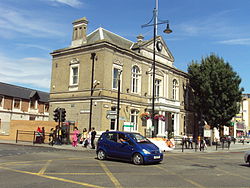 | Greater London | 1898 | Architect: Thomas Newall. | |
| Southampton | Civic Centre including Southampton Guildhall |  | Hampshire | 1932–39 | Grade II* listed (1092036). Architect: Ernest Berry Webber. | |
| South Cave | South Cave Town Hall |  | East Riding of Yorkshire | 1796 | Grade II listed (1203447). | |
| Southend-on-Sea | Southend Civic Centre |  | Essex | 1967 | Architect: Patrick Burridge. | |
| Southgate | Southgate Town Hall |  | Greater London | 1893 | Architect: Arthur Rowland Barker. | |
| South Molton | South Molton Guildhall |  | Devon | 1743 | Grade I listed (1106866). | |
| Southport | Southport Town Hall | 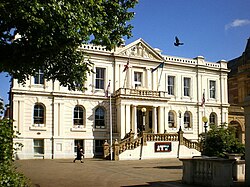 | Merseyside | 1853 | Grade II listed (1379678). Architect: Thomas Withnell. | |
| South Shields | South Shields Town Hall |  | Tyne and Wear | 1910 | 47 metres (154 ft) | Grade II listed (1232325). Architect: Ernest Fatch. |
| Southwick | Old Town Hall, Southwick |  | West Sussex | 1906 | Architect: George Walter Warr. | |
| Southwold | Southwold Town Hall |  | Suffolk | 1810 | Grade II listed (1384392). | |
| Sowerby Bridge | Sowerby Bridge Town Hall |  | West Yorkshire | 1857 | Grade II listed (1319977). Architects: William Perkin and Elisha Backhouse. | |
| Spennymoor | Spennymoor Town Hall |  | County Durham | 1916 | Architect: G. T. Wellburn. | |
| Spilsby | Old Town Hall, Spilsby |  | Lincolnshire | 1764 | Grade II listed (1063591). | |
| Stafford | Borough Hall, Stafford |  | Staffordshire | 1877 | Grade II listed (1195382). Architect: Henry Ward. | |
| Staines | Staines Town Hall |  | Surrey | 1880 | Grade II listed (1187053). Architect: John Johnson. | |
| Stamford | Stamford Town Hall |  | Lincolnshire | 1779 | Grade II* listed (1306544). Architect: Henry Tatam. | |
| St Albans | St Albans Town Hall |  | Hertfordshire | 1826 | Grade II listed (1296135). Architect: George Smith. | |
| St Albans | The Moot Hall |  | Hertfordshire | 1570 | Grade II listed (1103069). | |
| Stanhope | Stanhope Town Hall |  | County Durham | 1849 | ||
| Lytham St Annes | St Anne's Public Offices |  | Lancashire | 1902 | Grade II listed (1390771). Architect: Thomas Muirhead. | |
| St Austell | St Austell Town Hall |  | Cornwall | 1844 | Grade II* listed (1289697). Architect: Christopher Eales. | |
| St Helens | St Helens Town Hall |  | Merseyside | 1876 | ||
| St Ives | St Ives Town Hall |  | Cambridgeshire | 1850 | Grade II listed (1330649). Architect: George Allen. | |
| St Ives | St Ives Guildhall |  | Cornwall | 1939 | Locally listed. Architect: Geoffrey B. Drewitt. | |
| St John's Chapel | Upper Weardale Town Hall |  | County Durham | 1868 | ||
| St Just in Penwith | Old Town Hall, St Just |  | Cornwall | 1862 | ||
| St Marychurch | St Marychurch Town Hall |  | Devon | 1883 | Grade II listed (1208816). | |
| Stepney | Stepney Town Hall |  | Greater London | 1860 | Grade II listed (1242346). Architect: Andrew Wilson. | |
| Steyning | Old Town Hall, Steyning |  | West Sussex | 1886 | Grade II listed (1027267). Architect: Charles Dalby. | |
| Stockbridge | Stockbridge Town Hall |  | Hampshire | 1790 | Grade II* listed (1093093). | |
| Stockport | Stockport Town Hall |  | Greater Manchester | 1908 | 40 metres (131 ft) | Grade II* listed (1067166). Architect: Brumwell Thomas. |
| Stocksbridge | Stocksbridge Town Hall |  | South Yorkshire | 1928 | Architect: Henry Maynard Aitchison. | |
| Stockton-on-Tees | Stockton-on-Tees Town Hall |  | County Durham | 1735 | Grade II* listed (1139975). | |
| Stoke Newington | Stoke Newington Town Hall |  | Greater London | 1937 | Grade II listed (1253465). Architect: John Reginald Truelove. | |
| Stoke-upon-Trent | Stoke-upon-Trent Town Hall | 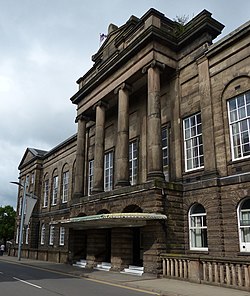 | Staffordshire | 1834 | Grade II listed (1297959). Architect: Henry Ward. | |
| Stokesley | Stokesley Town Hall |  | North Yorkshire | 1853 | Grade II listed (1315445). | |
| Stourbridge | Stourbridge Town Hall |  | West Midlands | 1887 | Grade II listed (1251260). Architect: Thomas Robinson. | |
| Stourport-on-Severn | Stourport Civic Centre |  | Worcestershire | 1966 | Architects: Andrews and Hazzard. | |
| Stratford | Stratford Town Hall | 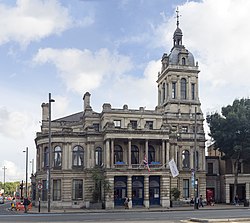 | Greater London | 1869 | 30.5 metres (100 ft) | Grade II listed (1080991). Architects: John Giles and Lewis Angell. |
| Stratford-upon-Avon | Stratford-upon-Avon Town Hall |  | Warwickshire | 1767 | Grade II* listed (1298545). Architect: Robert Newman. | |
| Stratford-upon-Avon | Stratford-upon-Avon Guildhall |  | Warwickshire | 1417 | Grade I listed (1187780). | |
| Stroud | Old Town Hall, Stroud |  | Gloucestershire | 1596 | Grade II* listed (1267688). | |
| Sudbury | Sudbury Town Hall | 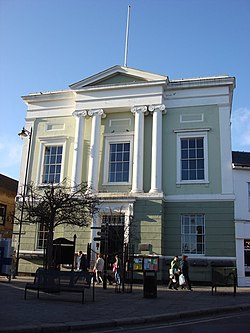 | Suffolk | 1830 | Grade II listed (1037452). Architect: John Johnston. | |
| Sunderland | Sunderland Civic Centre |  | Tyne and Wear | 1970 | Architects: Spence Bonnington & Collins. | |
| Sunderland | City Hall, Sunderland |  | Tyne and Wear | 2021 | Architects: FaulknerBrowns. | |
| Surbiton | Surbiton Town Hall |  | Greater London | 1898 | Grade II listed (1358440). | |
| Sutton | Sutton Civic Offices |  | Greater London | 1975 | Architect: Charles Sierakowski. | |
| Sutton Coldfield | Sutton Coldfield Town Hall |  | West Midlands | 1865 | Locally listed. | |
| Sutton-in-Ashfield | Sutton-in-Ashfield Town Hall |  | Nottinghamshire | 1889 | Architect: J. P. Adlington. | |
| Swadlincote | Swadlincote Town Hall |  | Derbyshire | 1861 | Grade II listed (1334526). | |
| Swaffham | Swaffham Town Hall |  | Norfolk | 1810 | Grade II listed (1269635). | |
| Swanage | Swanage Town Hall |  | Dorset | 1883 | Grade II listed (1323621). Architect: George Rackstraw Crickmay. | |
| Swindon | Swindon Civic Offices | 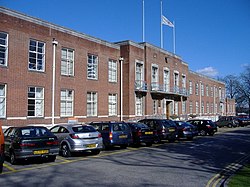 | Wiltshire | 1838 | Grade II listed (1467731). Architects: Bertram, Bertram and Rice. | |
| Swindon | Swindon Town Hall |  | Wiltshire | 1891 | 24 metres (79 ft) | Grade II listed (1355877). Architect: Brightwen Binyon of Ipswich. |
| Swindon | Old Town Hall, Swindon |  | Wiltshire | 1854 | Grade II listed (1023523). Architect: Sampson Sage and E Robertson. | |
| Tadcaster | Old Town Hall, Tadcaster |  | North Yorkshire | 1860 | Grade II listed (1316684) | |
| Tamworth | Tamworth Town Hall |  | Staffordshire | 1701 | Grade II* listed (1293012). Architect: William Gilkes. | |
| Taunton | Municipal Buildings, Taunton |  | Somerset | 1480 | Grade II* listed (1060041). | |
| Tavistock | Tavistock Town Hall |  | Devon | 1864 | Grade II listed (1105832). Architect: Edward Rundle. | |
| Tenterden | Tenterden Town Hall |  | Kent | 1792 | Grade II listed (1070343). | |
| Tetbury | Tetbury Town Hall |  | Gloucestershire | 1655 | Grade I listed (1303914). | |
| Tewkesbury | Tewkesbury Town Hall |  | Gloucestershire | 1788 | Grade II* listed (1206399). | |
| Thame | Thame Town Hall |  | Oxfordshire | 1887 | Grade II listed (1368763). Architect: Henry James Tollit. | |
| Thetford | Thetford Guildhall |  | Norfolk | 1901 | Grade II listed (1207867). Architect: Herbert John Green. | |
| Sowerby | Thirsk and Sowerby Town Hall |  | North Yorkshire | 1913 | Architect: Walter Brierley. | |
| Thornaby-on-Tees | Thornaby Town Hall |  | North Yorkshire | 1892 | Grade II listed (1320257). Architect: James Garry. | |
| Thornbury | Thornbury Town Hall |  | Gloucestershire | 1785 | Grade II listed (1128795). | |
| Tiverton | Tiverton Town Hall |  | Devon | 1864 | Grade II listed (1384734). Architect: Henry Lloyd. | |
| Todmorden | Todmorden Town Hall |  | West Yorkshire | 1875 | 20 metres (66 ft) | Grade I listed (1228980). Architect: John Gibson. |
| Torquay | Torquay Town Hall | 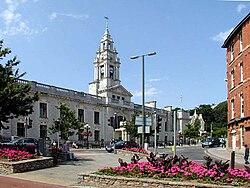 | Devon | 1911 | Grade II listed (1208247). Architect: Thomas Davison. | |
| Torquay | Old Town Hall, Torquay |  | Devon | 1852 | Grade II listed (1291593). Architect: Mr Dixon. | |
| Totnes | Totnes Guildhall |  | Devon | 1553 | Grade I listed (1235949). | |
| Tottenham | Tottenham Town Hall |  | Greater London | 1905 | Grade II listed (1249634). Architects: Arnold Taylor and R Jemmett. | |
| Tottington | Tottington Town Hall |  | Greater Manchester | 1820 | Grade II listed (1163648). | |
| Towcester | Towcester Town Hall |  | Northamptonshire | 1866 | Grade II listed (1371643). Architect: Thomas Heygate Vernon. | |
| Whitechapel | Tower Hamlets Town Hall |  | Greater London | 1757 | Grade II listed (1065788). Architect: Boulton Mainwaring. | |
| Toxteth | Toxteth Town Hall |  | Merseyside | 1866 | Grade II listed (1075218). Architect: Thomas Layland. | |
| Trafford | Trafford Town Hall | 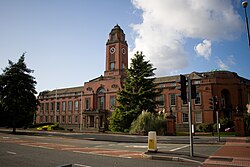 | Greater Manchester | 1933 | Grade II listed (1391923). Known as Stretford Town Hall until 1974. Architect: Bradshaw, Gass and Hope. | |
| Tring | Tring Market House |  | Hertfordshire | 1898 | Grade II listed (1083558). Architect: William Huckvale. | |
| Trowbridge | Trowbridge Town Hall |  | Wiltshire | 1889 | Grade II listed (1364209). Architect: Alfred Samuel Goodridge. | |
| Truro | Truro City Hall |  | Cornwall | 1846 | Grade II* listed (1201442). Architect: Christopher Eales. | |
| Royal Tunbridge Wells | Tunbridge Wells Town Hall |  | Kent | 1941 | Grade II listed (1265550). Architects: Sir Percy Thomas and Ernest Prestwich. | |
| Tunstall | Tunstall Town Hall |  | Staffordshire | 1885 | Grade II listed (1290967). Architect: Absalom Wood. | |
| Twickenham | York House |  | Greater London | 1630 | Grade II listed (1001548). | |
| Tyldesley | Tyldesley Town Hall |  | Greater Manchester | 1881 | ||
| North Shields | Tynemouth Town Hall |  | Tyne and Wear | 1845 | Grade II listed (1354989). Architect: John Dobson. | |
| Ulverston | Ulverston Town Hall |  | Cumbria | 1825 | ||
| Uppermill | Uppermill Civic Hall |  | Greater Manchester | 1859 | Architect: George Shaw. | |
| Upton upon Severn | Upton upon Severn Memorial Hall |  | Worcestershire | 1832 | Grade II listed (1227111). | |
| Uttoxeter | Uttoxeter Town Hall |  | Staffordshire | 1854 | Grade II listed (1253438). Architect: Thomas Fradgley. | |
| Uxbridge | Uxbridge Town Hall |  | Greater London | 1788 | Grade II* listed (1080208). | |
| Ventnor | Ventnor Town Hall |  | Isle of Wight | 1878 | Grade II listed (1224297). Architect: Theodore Ridley Saunders. | |
| Wadebridge | Wadebridge Town Hall |  | Cornwall | 1888 | Architect: C. E. Collins. | |
| Wakefield | Wakefield Town Hall |  | West Yorkshire | 1880 | 59 metres (194 ft) | Grade I listed (1258995). Architect: Thomas Edward Collcutt. |
| Wakefield | Old Town Hall, Wakefield |  | West Yorkshire | 1800 | Grade II listed (1259842). | |
| Wallasey | Wallasey Town Hall | 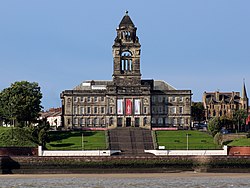 | Merseyside | 1920 | 55 metres (180 ft) | Grade II listed (1258467). Architects: Briggs, Wolstenholme & Thornely. |
| Wallingford | Wallingford Town Hall |  | Oxfordshire | 1670 | Grade I listed (1368477). | |
| Wallington | Wallington Town Hall | 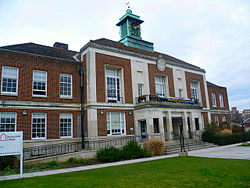 | Greater London | 1934 | Grade II listed (1392569). Architect: Robert Atkinson. | |
| Wallsend | Wallsend Town Hall |  | Tyne and Wear | 1908 | Grade II listed (1025330). Architect: E. F. W. Liddle and P. L. Brown. | |
| Walsall | Walsall Town Hall |  | West Midlands | 1903 | Grade II listed (1076367). Architect: J S Gibson. | |
| Walsall | Walsall Council House |  | West Midlands | 1905 | Grade II listed (1343029). Architect: J S Gibson. | |
| Waltham Abbey | Waltham Abbey Town Hall |  | Essex | 1904 | Locally listed. | |
| Waltham Forest | Waltham Forest Town Hall |  | Greater London | 1942 | Grade II listed (1190868). Known as Walthamstow Town Hall until 2014. Architect: Philip Hepworth. | |
| Walthamstow | Old Town Hall, Walthamstow |  | Greater London | 1866 | Grade II listed (1191150). | |
| Walworth | Walworth Town Hall |  | Greater London | 1865 | Grade II listed (1386028). Architect: Henry Jarvis. | |
| Wandsworth | Wandsworth Town Hall | 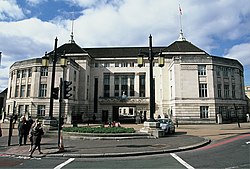 | Greater London | 1937 | Grade II listed (1244323). Architect: Edward A. Hunt. | |
| Wantage | Old Town Hall, Wantage |  | Oxfordshire | 1878 | Architect: William Tasker. | |
| Wareham | Wareham Town Hall |  | Dorset | 1870 | Architect: George Rackstraw Crickmay. | |
| Wark on Tyne | Wark Town Hall |  | Northumberland | 1874 | Grade II listed (1044953). | |
| Warminster | Warminster Town Hall |  | Wiltshire | 1837 | Grade II listed (1364438). Architect: Edward Blore. | |
| Warrington | Warrington Town Hall |  | Cheshire | 1750 | Grade I listed (1329725). Architect: James Gibbs. | |
| Warsop | Warsop Town Hall |  | Nottinghamshire | 1933 | ||
| Waterloo | Waterloo Town Hall |  | Merseyside | 1862 | Grade II listed (1257616). Architect: F. S. Spencer Yates. | |
| Watford | Watford Town Hall |  | Hertfordshire | 1939 | Grade II listed (1251002). Architect: Charles Cowles-Voysey. | |
| Wath upon Dearne | Wath upon Dearne Town Hall |  | South Yorkshire | 1770 | Grade II listed (1192631). | |
| Watlington | Watlington Town Hall |  | Oxfordshire | 1665 | Grade II* listed (1369012). | |
| Watton | Watton Town Hall |  | Norfolk | 1853 | Grade II listed (1076779). Architect: Edward Buckton Lamb. | |
| Wavertree | Wavertree Town Hall |  | Merseyside | 1872 | Grade II listed (1075219). Architect: John Elliot Reeve. | |
| Wednesbury | Wednesbury Town Hall |  | West Midlands | 1874 | Architect: Loxton Brothers. | |
| Wellington | Wellington Town Hall |  | Somerset | 1833 | Grade II listed (1059915). | |
| Wells | Wells Town Hall |  | Somerset | 1779 | Grade II listed (1383028). | |
| Welwyn Garden City | Welwyn Garden City Council Offices |  | Hertfordshire | 1937 | Architect: Cecil Harry Elsom. | |
| Wem | Wem Town Hall |  | Shropshire | 1905 | ||
| West Bromwich | West Bromwich Town Hall |  | West Midlands | 1874 | Grade II listed (1077117). Architects: Alexander & Henman of Stockton-on-Tees. | |
| Westbury | Old Town Hall, Westbury |  | Wiltshire | 1815 | Grade II* listed (1036308). | |
| Westhoughton | Westhoughton Town Hall |  | Greater Manchester | 1904 | Architects: Bradshaw and Gass. | |
| Westminster | Westminster City Hall | 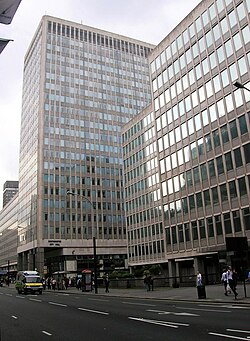 | Greater London | 1965 | 76 metres (249 ft) | Architects: Burnet Tait & Partners. |
| Westminster | Old City Hall, Westminster |  | Greater London | 1890 | Grade II listed (1066286). Architect: Robert Walker. | |
| Weston-super-Mare | Weston-super-Mare Town Hall |  | Somerset | 1859 | Grade II listed (1138148). Architects: James Wilson and Hans Price. | |
| Wetherby | Wetherby Town Hall |  | West Yorkshire | 1845 | Grade II listed (1135070). | |
| Weymouth | Weymouth Guildhall |  | Dorset | 1837 | Grade II listed (1132630). Architect: Talbot Bury. | |
| Weymouth | Weymouth Old Town Hall |  | Dorset | 1774 | Grade II listed (1141923). | |
| Whitby | Old Town Hall, Whitby |  | North Yorkshire | 1788 | Grade II* listed (1261706). Architect: Jonathan Pickernell. | |
| Whitchurch | Whitchurch Town Hall |  | Hampshire | 1791 | Grade II* listed (1092680). | |
| Whitchurch | Whitchurch Civic Centre |  | Shropshire | 1970 | ||
| Whitehaven | Whitehaven Town Hall |  | Cumbria | 1710 | Grade II listed (1086779). Architect: William Barnes. | |
| Whittlesey | Whittlesey Town Hall |  | Cambridgeshire | 1825 | Grade II listed (1228223). Architect: Richard Reynolds Rowe. | |
| Widnes | Widnes Town Hall |  | Cheshire | 1885 | Grade II listed (1330355). Architect: F. and G. Holme. | |
| Wigan | Wigan Town Hall |  | Greater Manchester | 1903 | Grade II listed (1384483). Architect: Briggs and Wolstenholme. | |
| Willenhall | Willenhall Town Hall |  | West Midlands | 1935 | Locally listed. | |
| Wilton | Old Town Hall, Wilton |  | Wiltshire | 1738 | Grade II listed (1023717). | |
| Wimbledon | Wimbledon Town Hall | 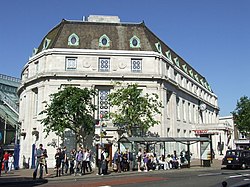 | Greater London | 1931 | Grade II listed (1358018). Architect: Bradshaw Gass & Hope. | |
| Wimborne Minster | Wimborne Minster Town Hall |  | Dorset | 1830 | Grade II listed (1323802). | |
| Wincanton | Wincanton Town Hall |  | Somerset | 1878 | Grade II listed (1274059). Architect: William John Willcox of Bath. | |
| Winchcombe | Winchcombe Town Hall |  | Gloucestershire | 1853 | Grade II listed (1091507). Architect: William Hill Knight. | |
| Winchelsea | Winchelsea Court Hall |  | East Sussex | 1294 | Grade I listed (1234513). | |
| Winchester | Winchester Guildhall | 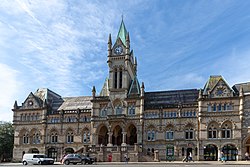 | Hampshire | 1875 | Grade II listed (1095464). Architects: Jeffery and Skiller. | |
| Windsor | Windsor Guildhall |  | Berkshire | 1689 | Grade I listed (1117752). | |
| Wirksworth | Wirksworth Town Hall |  | Derbyshire | 1873 | Architect: A. B. Bradby. | |
| Wisbech | Wisbech Town Hall |  | Cambridgeshire | 1811 | Grade II listed (1126633). Architect: Joseph Medworth. | |
| Witham | Witham Town Hall |  | Essex | 1800 | Grade II listed (1122592). | |
| Withington | Withington Town Hall |  | Greater Manchester | 1881 | Grade II listed (1291512). Architect: Lawrence Booth. | |
| Witney | Witney Town Hall |  | Oxfordshire | 1786 | Grade II* listed (1213347). Architect: Sir William Chambers. | |
| Wiveliscombe | Wiveliscombe Town Hall |  | Somerset | 1842 | Grade II listed (1307454). Architect: Richard Carver. | |
| Woburn | Woburn Town Hall |  | Bedfordshire | 1830 | Grade II listed (1321662). Architect: Edward Blore. | |
| Woking | Woking Civic Offices |  | Surrey | 1983 | ||
| Wokingham | Wokingham Town Hall |  | Berkshire | 1860 | 26 metres (85 ft) | Grade II* listed (1303481). Architects: William Ford Poulton and William Henry Woodman. |
| Wolsingham | Wolsingham Town Hall |  | County Durham | 1824 | ||
| Wolverhampton | Wolverhampton Civic Centre |  | West Midlands | 1978 | Architects: Clifford Culpin & Partners. | |
| Wolverhampton | Old Town Hall, Wolverhampton |  | West Midlands | 1871 | Grade II listed (1201845). Architect: Ernest Bates. | |
| Wombwell | Old Town Hall, Wombwell |  | South Yorkshire | 1900 | Locally listed. Architect: John Robinson. | |
| Woodstock | Woodstock Town Hall |  | Oxfordshire | 1767 | Grade II listed (1203847). Architect: Sir William Chambers. | |
| Woolwich | Woolwich Town Hall |  | Greater London | 1906 | 40 metres (131 ft) | Grade II* listed (1289668). Architect: Brumwell Thomas. |
| Woolwich | Old Town Hall, Woolwich |  | Greater London | 1842 | Grade II* listed (1079064). | |
| Wootton Bassett | Wootton Bassett Town Hall |  | Wiltshire | 1690 | Grade II listed (1363658). | |
| Worcester | Worcester Guildhall |  | Worcestershire | 1723 | Grade I listed (1389921). Architect: Thomas White. | |
| Worksop | Worksop Town Hall |  | Nottinghamshire | 1851 | Grade II listed (1045762). Architect: Isaac Charles Gilbert. | |
| Worthing | Worthing Town Hall |  | West Sussex | 1934 | Grade II listed (1250786). Architect: Charles Cowles-Voysey. | |
| Wotton-under-Edge | Wotton-under-Edge Town Hall |  | Gloucestershire | 1700 | Grade II listed (1341570). | |
| Wrentham | Old Town Hall, Wrentham |  | Suffolk | 1862 | Grade II listed (1352560). | |
| Wymondham | Wymondham Town Hall |  | Norfolk | 1820 | Grade II listed (1196687). | |
| Yardley | Yardley Council House |  | West Midlands | 1902 | Architect: Arthur Harrison. | |
| Yarm | Yarm Town Hall |  | North Yorkshire | 1710 | Grade II listed (1329488). | |
| Yarmouth | Yarmouth Town Hall |  | Isle of Wight | 1763 | Grade II listed (1292635). | |
| Yeadon | Yeadon Town Hall |  | West Yorkshire | 1880 | Grade II listed (1204098). Architect: William Hill of Leeds. | |
| Yeovil | Yeovil Town House |  | Somerset | 1849 | Grade II listed (1173857). Architect: Thomas Stent. | |
| York | York Guildhall |  | North Yorkshire | 1459 | Grade I listed (1257929). | |
